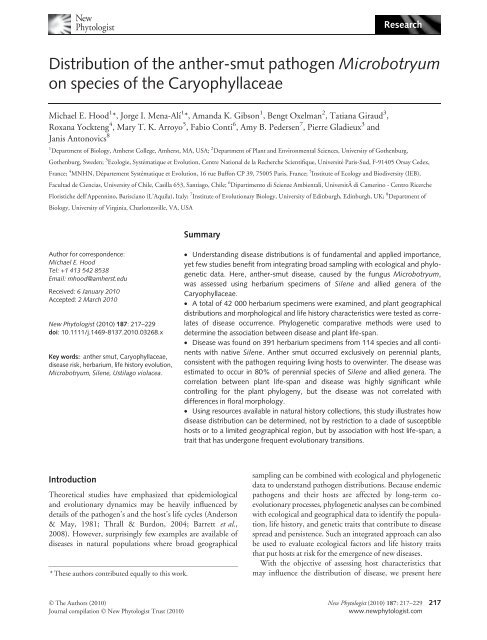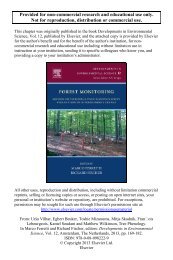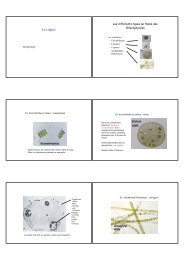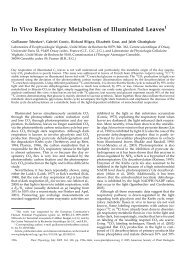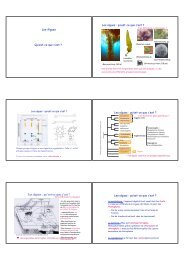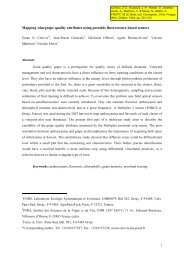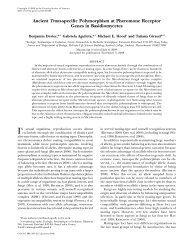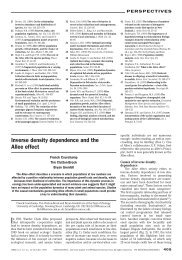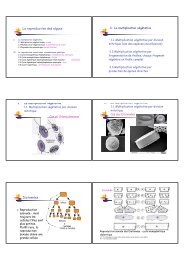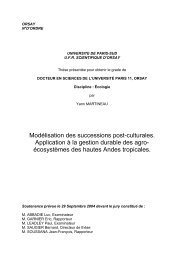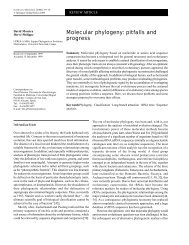Distribution of the anthersmut pathogen Microbotryum on species of ...
Distribution of the anthersmut pathogen Microbotryum on species of ...
Distribution of the anthersmut pathogen Microbotryum on species of ...
You also want an ePaper? Increase the reach of your titles
YUMPU automatically turns print PDFs into web optimized ePapers that Google loves.
NewPhytologistResearch<str<strong>on</strong>g>Distributi<strong>on</strong></str<strong>on</strong>g> <str<strong>on</strong>g>of</str<strong>on</strong>g> <str<strong>on</strong>g>the</str<strong>on</strong>g> an<str<strong>on</strong>g>the</str<strong>on</strong>g>r-smut <str<strong>on</strong>g>pathogen</str<strong>on</strong>g> <str<strong>on</strong>g>Microbotryum</str<strong>on</strong>g><strong>on</strong> <strong>species</strong> <str<strong>on</strong>g>of</str<strong>on</strong>g> <str<strong>on</strong>g>the</str<strong>on</strong>g> CaryophyllaceaeMichael E. Hood 1 *, Jorge I. Mena-Alí 1 *, Amanda K. Gibs<strong>on</strong> 1 , Bengt Oxelman 2 , Tatiana Giraud 3 ,Roxana Yockteng 4 , Mary T. K. Arroyo 5 , Fabio C<strong>on</strong>ti 6 , Amy B. Pedersen 7 , Pierre Gladieux 3 andJanis Ant<strong>on</strong>ovics 81 Department <str<strong>on</strong>g>of</str<strong>on</strong>g> Biology, Amherst College, Amherst, MA, USA; 2 Department <str<strong>on</strong>g>of</str<strong>on</strong>g> Plant and Envir<strong>on</strong>mental Sciences, University <str<strong>on</strong>g>of</str<strong>on</strong>g> Go<str<strong>on</strong>g>the</str<strong>on</strong>g>nburg,Go<str<strong>on</strong>g>the</str<strong>on</strong>g>nburg, Sweden; 3 Ecologie, Systématique et Evoluti<strong>on</strong>, Centre Nati<strong>on</strong>al de la Recherche Scientifique, Université Paris-Sud, F-91405 Orsay Cedex,France; 4 MNHN, Département Systématique et Evoluti<strong>on</strong>, 16 rue Buff<strong>on</strong> CP 39, 75005 Paris, France; 5 Institute <str<strong>on</strong>g>of</str<strong>on</strong>g> Ecology and Biodiversity (IEB),Facultad de Ciencias, University <str<strong>on</strong>g>of</str<strong>on</strong>g> Chile, Casilla 653, Santiago, Chile; 6 Dipartimento di Scienze Ambientali, Università di Camerino - Centro RicercheFloristiche dell’Appennino, Barisciano (L’Aquila), Italy; 7 Institute <str<strong>on</strong>g>of</str<strong>on</strong>g> Evoluti<strong>on</strong>ary Biology, University <str<strong>on</strong>g>of</str<strong>on</strong>g> Edinburgh, Edinburgh, UK; 8 Department <str<strong>on</strong>g>of</str<strong>on</strong>g>Biology, University <str<strong>on</strong>g>of</str<strong>on</strong>g> Virginia, Charlottesville, VA, USASummaryAuthor for corresp<strong>on</strong>dence:Michael E. HoodTel: +1 413 542 8538Email: mhood@amherst.eduReceived: 6 January 2010Accepted: 2 March 2010New Phytologist (2010) 187: 217–229doi: 10.1111/j.1469-8137.2010.03268.xKey words: an<str<strong>on</strong>g>the</str<strong>on</strong>g>r smut, Caryophyllaceae,disease risk, herbarium, life history evoluti<strong>on</strong>,<str<strong>on</strong>g>Microbotryum</str<strong>on</strong>g>, Silene, Ustilago violacea.• Understanding disease distributi<strong>on</strong>s is <str<strong>on</strong>g>of</str<strong>on</strong>g> fundamental and applied importance,yet few studies benefit from integrating broad sampling with ecological and phylogeneticdata. Here, an<str<strong>on</strong>g>the</str<strong>on</strong>g>r-smut disease, caused by <str<strong>on</strong>g>the</str<strong>on</strong>g> fungus <str<strong>on</strong>g>Microbotryum</str<strong>on</strong>g>,was assessed using herbarium specimens <str<strong>on</strong>g>of</str<strong>on</strong>g> Silene and allied genera <str<strong>on</strong>g>of</str<strong>on</strong>g> <str<strong>on</strong>g>the</str<strong>on</strong>g>Caryophyllaceae.• A total <str<strong>on</strong>g>of</str<strong>on</strong>g> 42 000 herbarium specimens were examined, and plant geographicaldistributi<strong>on</strong>s and morphological and life history characteristics were tested as correlates<str<strong>on</strong>g>of</str<strong>on</strong>g> disease occurrence. Phylogenetic comparative methods were used todetermine <str<strong>on</strong>g>the</str<strong>on</strong>g> associati<strong>on</strong> between disease and plant life-span.• Disease was found <strong>on</strong> 391 herbarium specimens from 114 <strong>species</strong> and all c<strong>on</strong>tinentswith native Silene. An<str<strong>on</strong>g>the</str<strong>on</strong>g>r smut occurred exclusively <strong>on</strong> perennial plants,c<strong>on</strong>sistent with <str<strong>on</strong>g>the</str<strong>on</strong>g> <str<strong>on</strong>g>pathogen</str<strong>on</strong>g> requiring living hosts to overwinter. The disease wasestimated to occur in 80% <str<strong>on</strong>g>of</str<strong>on</strong>g> perennial <strong>species</strong> <str<strong>on</strong>g>of</str<strong>on</strong>g> Silene and allied genera. Thecorrelati<strong>on</strong> between plant life-span and disease was highly significant whilec<strong>on</strong>trolling for <str<strong>on</strong>g>the</str<strong>on</strong>g> plant phylogeny, but <str<strong>on</strong>g>the</str<strong>on</strong>g> disease was not correlated withdifferences in floral morphology.• Using resources available in natural history collecti<strong>on</strong>s, this study illustrates howdisease distributi<strong>on</strong> can be determined, not by restricti<strong>on</strong> to a clade <str<strong>on</strong>g>of</str<strong>on</strong>g> susceptiblehosts or to a limited geographical regi<strong>on</strong>, but by associati<strong>on</strong> with host life-span, atrait that has underg<strong>on</strong>e frequent evoluti<strong>on</strong>ary transiti<strong>on</strong>s.Introducti<strong>on</strong>Theoretical studies have emphasized that epidemiologicaland evoluti<strong>on</strong>ary dynamics may be heavily influenced bydetails <str<strong>on</strong>g>of</str<strong>on</strong>g> <str<strong>on</strong>g>the</str<strong>on</strong>g> <str<strong>on</strong>g>pathogen</str<strong>on</strong>g>’s and <str<strong>on</strong>g>the</str<strong>on</strong>g> host’s life cycles (Anders<strong>on</strong>& May, 1981; Thrall & Burd<strong>on</strong>, 2004; Barrett et al.,2008). However, surprisingly few examples are available <str<strong>on</strong>g>of</str<strong>on</strong>g>diseases in natural populati<strong>on</strong>s where broad geographical* These authors c<strong>on</strong>tributed equally to this work.sampling can be combined with ecological and phylogeneticdata to understand <str<strong>on</strong>g>pathogen</str<strong>on</strong>g> distributi<strong>on</strong>s. Because endemic<str<strong>on</strong>g>pathogen</str<strong>on</strong>g>s and <str<strong>on</strong>g>the</str<strong>on</strong>g>ir hosts are affected by l<strong>on</strong>g-term coevoluti<strong>on</strong>aryprocesses, phylogenetic analyses can be combinedwith ecological and geographical data to identify <str<strong>on</strong>g>the</str<strong>on</strong>g> populati<strong>on</strong>,life history, and genetic traits that c<strong>on</strong>tribute to diseasespread and persistence. Such an integrated approach can alsobe used to evaluate ecological factors and life history traitsthat put hosts at risk for <str<strong>on</strong>g>the</str<strong>on</strong>g> emergence <str<strong>on</strong>g>of</str<strong>on</strong>g> new diseases.With <str<strong>on</strong>g>the</str<strong>on</strong>g> objective <str<strong>on</strong>g>of</str<strong>on</strong>g> assessing host characteristics thatmay influence <str<strong>on</strong>g>the</str<strong>on</strong>g> distributi<strong>on</strong> <str<strong>on</strong>g>of</str<strong>on</strong>g> disease, we present hereÓ The Authors (2010)Journal compilati<strong>on</strong> Ó New Phytologist Trust (2010)New Phytologist (2010) 187: 217–229 217www.newphytologist.com
218 ResearchNewPhytologist<str<strong>on</strong>g>the</str<strong>on</strong>g> results <str<strong>on</strong>g>of</str<strong>on</strong>g> a world-wide survey <str<strong>on</strong>g>of</str<strong>on</strong>g> <str<strong>on</strong>g>the</str<strong>on</strong>g> incidence <str<strong>on</strong>g>of</str<strong>on</strong>g> an<str<strong>on</strong>g>the</str<strong>on</strong>g>rsmutdisease using a survey <str<strong>on</strong>g>of</str<strong>on</strong>g> over 42 000 herbariumspecimens <str<strong>on</strong>g>of</str<strong>on</strong>g> plant <strong>species</strong> in <str<strong>on</strong>g>the</str<strong>on</strong>g> genus Silene and alliedgenera <str<strong>on</strong>g>of</str<strong>on</strong>g> <str<strong>on</strong>g>the</str<strong>on</strong>g> Caryophyllaceae. The disease is vectored byinsect pollinators and replaces <str<strong>on</strong>g>the</str<strong>on</strong>g> pollen in an<str<strong>on</strong>g>the</str<strong>on</strong>g>rs <str<strong>on</strong>g>of</str<strong>on</strong>g>infected plants with fungal spores. The dark fungal sporesin <str<strong>on</strong>g>the</str<strong>on</strong>g> an<str<strong>on</strong>g>the</str<strong>on</strong>g>rs <str<strong>on</strong>g>of</str<strong>on</strong>g> infected plants can be recognized <strong>on</strong>herbarium specimens and c<strong>on</strong>firmed by simple microscopy.However, <str<strong>on</strong>g>the</str<strong>on</strong>g> disease is sufficiently inc<strong>on</strong>spicuous that plantcollecti<strong>on</strong>s appear to have been made without awareness <str<strong>on</strong>g>of</str<strong>on</strong>g><str<strong>on</strong>g>the</str<strong>on</strong>g> disease (Ant<strong>on</strong>ovics et al., 2003; Hood & Ant<strong>on</strong>ovics,2003). Similar surveys <str<strong>on</strong>g>of</str<strong>on</strong>g> herbarium specimens have provenincreasingly useful for understanding a variety <str<strong>on</strong>g>of</str<strong>on</strong>g> o<str<strong>on</strong>g>the</str<strong>on</strong>g>rnaturally occurring diseases (Evans, 1987; Alexander et al.,2007; Malmstrom et al., 2007).An<str<strong>on</strong>g>the</str<strong>on</strong>g>r-smut disease is caused by <str<strong>on</strong>g>the</str<strong>on</strong>g> basidiomycetefungus <str<strong>on</strong>g>Microbotryum</str<strong>on</strong>g> violaceum sensu lato. Although relativelyuniform morphologically, M. violaceum <strong>on</strong> <str<strong>on</strong>g>the</str<strong>on</strong>g>Caryophyllaceae forms a large <strong>species</strong> complex with manyspecialized and evoluti<strong>on</strong>arily independent lineages, some<str<strong>on</strong>g>of</str<strong>on</strong>g> which have been elevated recently to <str<strong>on</strong>g>the</str<strong>on</strong>g> level <str<strong>on</strong>g>of</str<strong>on</strong>g> distinct<strong>species</strong> (Lutz et al., 2005; Le Gac et al., 2007; Giraud et al.,2008). An<str<strong>on</strong>g>the</str<strong>on</strong>g>r smut is <strong>on</strong>e <str<strong>on</strong>g>of</str<strong>on</strong>g> <str<strong>on</strong>g>the</str<strong>on</strong>g> best studied n<strong>on</strong>agriculturaldiseases <str<strong>on</strong>g>of</str<strong>on</strong>g> plants, particularly in <str<strong>on</strong>g>the</str<strong>on</strong>g> c<strong>on</strong>text <str<strong>on</strong>g>of</str<strong>on</strong>g><str<strong>on</strong>g>pathogen</str<strong>on</strong>g> ecology, phylogeny, and genetics (Ant<strong>on</strong>ovicset al., 2002; Garber & Ruddat, 2002; Giraud et al., 2008;Bernasc<strong>on</strong>i et al., 2009).An<str<strong>on</strong>g>the</str<strong>on</strong>g>r-smut epidemiology can be driven by <str<strong>on</strong>g>the</str<strong>on</strong>g> host’sphysiological resistance and by traits such as host life-span,mating system, floral displays, and pollinator specificity(Thrall et al., 1993; Marr & Delph, 2005). Such fundamentalplant traits are known to be under intense selecti<strong>on</strong>across diverse envir<strong>on</strong>mental and ecological c<strong>on</strong>diti<strong>on</strong>s(Crawford & Abbott, 1994; Giles et al., 2006), and <str<strong>on</strong>g>the</str<strong>on</strong>g>yvary to a large degree am<strong>on</strong>g caryophyllaceous plants(Desfeux et al., 1996; Kephart et al., 2006). Combinedwith <str<strong>on</strong>g>the</str<strong>on</strong>g>oretical models <strong>on</strong> how this disease interacts withhost life history traits, Thrall et al. (1993) showed that publishedreports <str<strong>on</strong>g>of</str<strong>on</strong>g> an<str<strong>on</strong>g>the</str<strong>on</strong>g>r smut <strong>on</strong> <str<strong>on</strong>g>the</str<strong>on</strong>g> Caryophyllaceae weremost frequent for perennial plant <strong>species</strong> and outcrossingsubfamilies, with a trend toward <strong>species</strong> with larger flowersbeing more likely to be diseased. The survey by Thrall et al.(1993) included <strong>species</strong> from Europe and North America,which was <str<strong>on</strong>g>the</str<strong>on</strong>g> recognized range <str<strong>on</strong>g>of</str<strong>on</strong>g> <str<strong>on</strong>g>the</str<strong>on</strong>g> <str<strong>on</strong>g>pathogen</str<strong>on</strong>g> at<str<strong>on</strong>g>the</str<strong>on</strong>g> time. While <str<strong>on</strong>g>the</str<strong>on</strong>g> Caryophyllaceae has a world-widedistributi<strong>on</strong>, it has been comm<strong>on</strong>ly accepted that an<str<strong>on</strong>g>the</str<strong>on</strong>g>rsmutfungi are largely limited to temperate and subarcticregi<strong>on</strong>s <str<strong>on</strong>g>of</str<strong>on</strong>g> <str<strong>on</strong>g>the</str<strong>on</strong>g> Nor<str<strong>on</strong>g>the</str<strong>on</strong>g>rn Hemisphere, although targetedsurveys have not yet been c<strong>on</strong>ducted in o<str<strong>on</strong>g>the</str<strong>on</strong>g>r regi<strong>on</strong>s (butsee Piepenbring, 2001; Marr & Delph, 2005). A tacitassumpti<strong>on</strong> has been that <str<strong>on</strong>g>the</str<strong>on</strong>g> <str<strong>on</strong>g>pathogen</str<strong>on</strong>g>’s geographical rangeis limited by climate, with cooler temperatures favoringtransmissi<strong>on</strong>, or by latitudinal changes in <str<strong>on</strong>g>the</str<strong>on</strong>g> proporti<strong>on</strong> <str<strong>on</strong>g>of</str<strong>on</strong>g>annual to perennial <strong>species</strong>.To test <str<strong>on</strong>g>the</str<strong>on</strong>g> generality <str<strong>on</strong>g>of</str<strong>on</strong>g> <str<strong>on</strong>g>the</str<strong>on</strong>g> patterns described above,data <strong>on</strong> <str<strong>on</strong>g>the</str<strong>on</strong>g> presence <str<strong>on</strong>g>of</str<strong>on</strong>g> an<str<strong>on</strong>g>the</str<strong>on</strong>g>r-smut disease in herbariumspecimens were analyzed for associati<strong>on</strong>s with plant lifespan,floral characteristics, and geographical distributi<strong>on</strong>s.This research greatly expands up<strong>on</strong> <str<strong>on</strong>g>the</str<strong>on</strong>g> previous study byThrall et al. (1993), where <str<strong>on</strong>g>the</str<strong>on</strong>g> incidence <str<strong>on</strong>g>of</str<strong>on</strong>g> an<str<strong>on</strong>g>the</str<strong>on</strong>g>r smut inrelati<strong>on</strong> to floral and life history characters was largely based<strong>on</strong> a literature survey, and geographical distributi<strong>on</strong>s andhost phylogeny were not explicitly c<strong>on</strong>sidered. Our goalswere: first, to determine <str<strong>on</strong>g>the</str<strong>on</strong>g> degree to which <str<strong>on</strong>g>the</str<strong>on</strong>g> disease isc<strong>on</strong>fined to perennial plant <strong>species</strong>; sec<strong>on</strong>dly, to predict <str<strong>on</strong>g>the</str<strong>on</strong>g>proporti<strong>on</strong> <str<strong>on</strong>g>of</str<strong>on</strong>g> perennial <strong>species</strong> expected to harbor <str<strong>on</strong>g>the</str<strong>on</strong>g> diseasein nature; thirdly, to assess whe<str<strong>on</strong>g>the</str<strong>on</strong>g>r disease frequenciesam<strong>on</strong>g perennials were associated with <str<strong>on</strong>g>the</str<strong>on</strong>g> plants’ geographicaldistributi<strong>on</strong>s or floral characteristics; and fourthly,to establish whe<str<strong>on</strong>g>the</str<strong>on</strong>g>r <str<strong>on</strong>g>the</str<strong>on</strong>g>se relati<strong>on</strong>ships had evolved independentlywith regard to <str<strong>on</strong>g>the</str<strong>on</strong>g> host phylogeny. To establishwhe<str<strong>on</strong>g>the</str<strong>on</strong>g>r an<str<strong>on</strong>g>the</str<strong>on</strong>g>r-smut disease observed <strong>on</strong> specimens fromdistant hosts or geographical regi<strong>on</strong>s could be included in<str<strong>on</strong>g>the</str<strong>on</strong>g> discussi<strong>on</strong> <str<strong>on</strong>g>of</str<strong>on</strong>g> fungi in <str<strong>on</strong>g>the</str<strong>on</strong>g> genus <str<strong>on</strong>g>Microbotryum</str<strong>on</strong>g>, we alsocarried out a limited phylogenetic study <strong>on</strong> a subset <str<strong>on</strong>g>of</str<strong>on</strong>g> <str<strong>on</strong>g>pathogen</str<strong>on</strong>g>samples from <str<strong>on</strong>g>the</str<strong>on</strong>g> herbaria using DNA sequencing.The current study covers a much larger geographical areaand a more inclusive list <str<strong>on</strong>g>of</str<strong>on</strong>g> plant <strong>species</strong> than previousinvestigati<strong>on</strong>s (Thrall et al., 1993; Ant<strong>on</strong>ovics et al., 2003).The study reveals <str<strong>on</strong>g>the</str<strong>on</strong>g> nearly global distributi<strong>on</strong> <str<strong>on</strong>g>of</str<strong>on</strong>g> an<str<strong>on</strong>g>the</str<strong>on</strong>g>rsmutdisease <strong>on</strong> <str<strong>on</strong>g>the</str<strong>on</strong>g> Caryophyllaceae while also assessing <str<strong>on</strong>g>the</str<strong>on</strong>g>relati<strong>on</strong>ships between infecti<strong>on</strong> and host traits in a quantitativeand phylogenetic c<strong>on</strong>text.Materials and MethodsNatural historyAn<str<strong>on</strong>g>the</str<strong>on</strong>g>r-smut disease <strong>on</strong> <str<strong>on</strong>g>the</str<strong>on</strong>g> Caryophyllaceae is caused byfungal <strong>species</strong> <str<strong>on</strong>g>of</str<strong>on</strong>g> <str<strong>on</strong>g>the</str<strong>on</strong>g> genus <str<strong>on</strong>g>Microbotryum</str<strong>on</strong>g> (Basidiomycetes:Microbotryales). Related fungal <str<strong>on</strong>g>pathogen</str<strong>on</strong>g>s, <str<strong>on</strong>g>of</str<strong>on</strong>g>ten classifiedin separate genera, are found <strong>on</strong> o<str<strong>on</strong>g>the</str<strong>on</strong>g>r plant families,including <str<strong>on</strong>g>the</str<strong>on</strong>g> Dipsacaceae, Lamiaceae, Polyg<strong>on</strong>aceae, andPortulacaceae (Kemler et al., 2006, 2009). Although sometimesreferred to as a single <strong>species</strong>, <str<strong>on</strong>g>the</str<strong>on</strong>g> name <str<strong>on</strong>g>Microbotryum</str<strong>on</strong>g>violaceum represents a suite <str<strong>on</strong>g>of</str<strong>on</strong>g> host-specific <strong>species</strong> thatremain incompletely resolved tax<strong>on</strong>omically (Le Gac et al.,2007; Lutz et al., 2008; Denchev et al., 2009); <str<strong>on</strong>g>the</str<strong>on</strong>g>refore<str<strong>on</strong>g>the</str<strong>on</strong>g> genus name <str<strong>on</strong>g>Microbotryum</str<strong>on</strong>g> is used hereafter. Many<strong>species</strong> in <str<strong>on</strong>g>the</str<strong>on</strong>g> Caryophyllaceae are hosts to an<str<strong>on</strong>g>the</str<strong>on</strong>g>r smut,particularly within <str<strong>on</strong>g>the</str<strong>on</strong>g> genus Silene (Thrall et al., 1993).An<str<strong>on</strong>g>the</str<strong>on</strong>g>r-smut disease sterilizes infected hosts by causingfemale structures to abort and replacing pollen withpowdery, dark-colored fungal spores. The disease is transmittedprimarily by pollinators visiting infected flowers(Ant<strong>on</strong>ovics & Alexander, 1992; Biere & H<strong>on</strong>ders, 1998).The Caryophyllaceae c<strong>on</strong>sists almost exclusively <str<strong>on</strong>g>of</str<strong>on</strong>g> herbaceousplant <strong>species</strong>, representing a diverse range <str<strong>on</strong>g>of</str<strong>on</strong>g> ecologiesNew Phytologist (2010) 187: 217–229www.newphytologist.comÓ The Authors (2010)Journal compilati<strong>on</strong> Ó New Phytologist Trust (2010)
NewPhytologist Research 219and life histories from annuals to extremely l<strong>on</strong>g-livedperennials (e.g. Desfeux et al., 1996; Forbis & Doak, 2004;Kephart et al., 2006). Within this family, an<str<strong>on</strong>g>the</str<strong>on</strong>g>r-smut diseaseis most comm<strong>on</strong> <strong>on</strong> <str<strong>on</strong>g>the</str<strong>on</strong>g> tribe Sileneae (Oxelman et al.,2001; Table 2; Thrall et al., 1993). Europe and Asia c<strong>on</strong>tain<str<strong>on</strong>g>the</str<strong>on</strong>g> largest numbers <str<strong>on</strong>g>of</str<strong>on</strong>g> <strong>species</strong> in <str<strong>on</strong>g>the</str<strong>on</strong>g> Sileneae, withsmaller numbers found in Africa and North America andyet fewer in South America (Heywood, 1978). A suggestedphylogeographical history <str<strong>on</strong>g>of</str<strong>on</strong>g> <str<strong>on</strong>g>the</str<strong>on</strong>g> genus Silene is a Eurasianorigin followed by migrati<strong>on</strong> into <str<strong>on</strong>g>the</str<strong>on</strong>g> Americas via <str<strong>on</strong>g>the</str<strong>on</strong>g>Beringian regi<strong>on</strong> (Popp et al., 2005; Popp & Oxelman,2007). There are no native members <str<strong>on</strong>g>of</str<strong>on</strong>g> <str<strong>on</strong>g>the</str<strong>on</strong>g> Sileneae inAustralia, although some <strong>species</strong> have become naturalizedfollowing introducti<strong>on</strong>.Herbarium surveysSpecimens were examined from <str<strong>on</strong>g>the</str<strong>on</strong>g> following plant herbaria(with herbarium abbreviati<strong>on</strong>s according to Holmgren &Holmgren, 1998): European: Centro di Ricerche Floristichedell’Appennino (APP); Botánico de Barcel<strong>on</strong>a (BC);Instituto Museo di Storia Naturale dell’Università, Firenze(FI); Royal Botanical Gardens, Kew (K); Real JardínBotánico de Madrid (MA); Muséum Nati<strong>on</strong>al d’HistoireNaturelle, Paris (P); North American: Gray Herbarium,Harvard University (GH); Missouri Botanical Garden(MO); New York Botanical Garden (NY); Smiths<strong>on</strong>ianInstituti<strong>on</strong>, Washingt<strong>on</strong>, DC (US); African: BolusHerbarium (BOL); South American: Museo Naci<strong>on</strong>al deHistoría Natural, Santiago, Chile (SGO); Asian: JiangsuInstitute <str<strong>on</strong>g>of</str<strong>on</strong>g> Botany, Nanjing (NAS). The survey focused <strong>on</strong><str<strong>on</strong>g>the</str<strong>on</strong>g> genus Silene and o<str<strong>on</strong>g>the</str<strong>on</strong>g>r genera in <str<strong>on</strong>g>the</str<strong>on</strong>g> tribe Sileneae. Somemembers <str<strong>on</strong>g>of</str<strong>on</strong>g> <str<strong>on</strong>g>the</str<strong>on</strong>g> subfamilies Caryophylloideae (i.e.Sap<strong>on</strong>aria, Dianthus, and Petrorhagia) and Alsinoideae (i.e.Stellaria) were also examined (Table 1), as were North andSouth American members <str<strong>on</strong>g>of</str<strong>on</strong>g> <str<strong>on</strong>g>the</str<strong>on</strong>g> genus Calandrinia in <str<strong>on</strong>g>the</str<strong>on</strong>g>Portulacaceae as a result <str<strong>on</strong>g>of</str<strong>on</strong>g> <str<strong>on</strong>g>the</str<strong>on</strong>g> recent discovery <str<strong>on</strong>g>of</str<strong>on</strong>g> an an<str<strong>on</strong>g>the</str<strong>on</strong>g>rsmut <strong>on</strong> Calandrinia that is related to <str<strong>on</strong>g>Microbotryum</str<strong>on</strong>g> <strong>on</strong>Silene (Le Gac et al., 2007). Each herbarium sheet wasexamined for specimens with diseased flowers, and countswere based <strong>on</strong> total number <str<strong>on</strong>g>of</str<strong>on</strong>g> sheets with or withoutdiseased specimens; no attempt was made to distinguishindividual plants (see Hood & Ant<strong>on</strong>ovics, 2003).Locality informati<strong>on</strong> from herbarium labels <str<strong>on</strong>g>of</str<strong>on</strong>g> <str<strong>on</strong>g>the</str<strong>on</strong>g> diseasedspecimens was recorded and used to generate a distributi<strong>on</strong>map <str<strong>on</strong>g>of</str<strong>on</strong>g> an<str<strong>on</strong>g>the</str<strong>on</strong>g>r-smut disease found in this survey. In no casedid we find any annotati<strong>on</strong> indicating that <str<strong>on</strong>g>the</str<strong>on</strong>g> collectormight have noticed that specimens <strong>on</strong> <str<strong>on</strong>g>the</str<strong>on</strong>g> sheets werediseased.To determine how representative <str<strong>on</strong>g>the</str<strong>on</strong>g> herbarium surveywas <str<strong>on</strong>g>of</str<strong>on</strong>g> <str<strong>on</strong>g>the</str<strong>on</strong>g> <strong>species</strong> in <str<strong>on</strong>g>the</str<strong>on</strong>g> tribe Sileneae, a simulati<strong>on</strong> analysiswas performed based up<strong>on</strong> resampling specimens from <str<strong>on</strong>g>the</str<strong>on</strong>g>compiled data set. Entries were chosen from <str<strong>on</strong>g>the</str<strong>on</strong>g> data set <str<strong>on</strong>g>of</str<strong>on</strong>g>over 40 000 Sileneae specimens at random and with replacement,and each was assessed for whe<str<strong>on</strong>g>the</str<strong>on</strong>g>r <str<strong>on</strong>g>the</str<strong>on</strong>g> plant <strong>species</strong>had been sampled previously in <str<strong>on</strong>g>the</str<strong>on</strong>g> simulati<strong>on</strong>. Theexpected number <str<strong>on</strong>g>of</str<strong>on</strong>g> new plant <strong>species</strong> added for each additi<strong>on</strong>alherbarium specimen was determined. After <str<strong>on</strong>g>the</str<strong>on</strong>g> first20 000 specimens <str<strong>on</strong>g>the</str<strong>on</strong>g> rate <str<strong>on</strong>g>of</str<strong>on</strong>g> new plant <strong>species</strong> per specimenhad reached a relatively c<strong>on</strong>stant value <str<strong>on</strong>g>of</str<strong>on</strong>g> c. 0.003. We <str<strong>on</strong>g>the</str<strong>on</strong>g>reforec<strong>on</strong>cluded that <str<strong>on</strong>g>the</str<strong>on</strong>g> database was sufficiently large andrepresentative to provide a thorough survey <str<strong>on</strong>g>of</str<strong>on</strong>g> <str<strong>on</strong>g>the</str<strong>on</strong>g> Sileneae.Table 1 Number <str<strong>on</strong>g>of</str<strong>on</strong>g> herbarium specimens examined for an<str<strong>on</strong>g>the</str<strong>on</strong>g>r-smut disease classified by plant genus and life-spanFamily CaryophyllaceaeSubfamily CaryophylloideaeTotal Perennial Annual UndeterminedTribe Sileneae Silene 37 275 (728) 24 136 (514) 13 008 (141) 131 (73)Lychnis 1471 (31) 1469 (29) 1 (1) 1 (1)Heliosperma 275 (7) 275 (7) 0 (0) 0 (0)Viscaria 501 (3) 501 (3) 0 (0) 0 (0)Atoci<strong>on</strong> 542 (4) 542 (4) 0 (0) 0 (0)Eudian<str<strong>on</strong>g>the</str<strong>on</strong>g> 530 (2) 0 (0) 530 (2) 0 (0)Agrostemma 6 (1) 0 (0) 6 (1) 0 (0)Remaining Caryophylloideae Sap<strong>on</strong>aria 336 (67) 282 (38) 8 (3) 46 (26)Dianthus 482 (24) 431 (8) 36 (8) 15 (8)Petrorhagia 21 (2) 11 (1) 10 (1) 0 (0)Remaining Caryophyllaceae Stellaria 398 (4) 398 (4) 0 (0) 0 (0)Family Portulaceae Calandrinia 772 (72) 311 (21) 425 (40) 36 (11)Cistan<str<strong>on</strong>g>the</str<strong>on</strong>g> 3 (2) 3 (2) 0 (0) 0 (0)Ceraria 20 (4) 20 (4) 0 (0) 0 (0)Calyptro<str<strong>on</strong>g>the</str<strong>on</strong>g>ca 77 (3) 0 (0) 77 (3) 0 (0)Total 42 709 (955) 28 379 (636) 14 101 (200) 229 (119)Numbers <str<strong>on</strong>g>of</str<strong>on</strong>g> <strong>species</strong> per genus are shown in paren<str<strong>on</strong>g>the</str<strong>on</strong>g>ses. The tribe Sileneae is as defined in Oxelman et al. (2001).Ó The Authors (2010)Journal compilati<strong>on</strong> Ó New Phytologist Trust (2010)New Phytologist (2010) 187: 217–229www.newphytologist.com
220 ResearchNewPhytologistPlant characteristicsTo assess factors that may explain <str<strong>on</strong>g>the</str<strong>on</strong>g> disease frequencies,informati<strong>on</strong> was compiled for <str<strong>on</strong>g>the</str<strong>on</strong>g> life-span (annual orperennial), petal limb length, and flower color <str<strong>on</strong>g>of</str<strong>on</strong>g> each<strong>species</strong> (see Supporting Informati<strong>on</strong> Table S1). Specieslisted as biennial were included with annuals, and <strong>species</strong>listed variably as annual ⁄ perennial or biennial ⁄ perennialwere included with perennials. Biennial <strong>species</strong> wereincluded with annuals because, like annuals, individuals d<strong>on</strong>ot exhibit repeated flowering which is necessary for <str<strong>on</strong>g>the</str<strong>on</strong>g> persistence<str<strong>on</strong>g>of</str<strong>on</strong>g> this pollinator-transmitted disease over successiveseas<strong>on</strong>s (Thrall et al., 1993); moreover, <strong>species</strong> with a winterannualhabit are sometimes described in <str<strong>on</strong>g>the</str<strong>on</strong>g> literature asbiennial. The floral trait <str<strong>on</strong>g>of</str<strong>on</strong>g> petal limb length was used as aproxy for flower size; a previous study had suggested a positiverelati<strong>on</strong>ship between flower size and disease incidence(Thrall et al., 1993). The darkness <str<strong>on</strong>g>of</str<strong>on</strong>g> flower color was alsoinvestigated because we were c<strong>on</strong>cerned that it might biascollecti<strong>on</strong> <str<strong>on</strong>g>of</str<strong>on</strong>g> diseased plants by collectors, <str<strong>on</strong>g>the</str<strong>on</strong>g> disease beingmore c<strong>on</strong>spicuous <strong>on</strong> white-colored flowers. The darkness <str<strong>on</strong>g>of</str<strong>on</strong>g>flower color was assessed <strong>on</strong> a scale from 1 to 4: 1, white; 2,white-yellow, white-green, or white-pink; 3, pink, violet,red-white, or lilac; 4, red, red-violet, dark red, or dark violet.Data <strong>on</strong> plant traits were ga<str<strong>on</strong>g>the</str<strong>on</strong>g>red from various sourcesincluding floras (Flora <str<strong>on</strong>g>of</str<strong>on</strong>g> North America,Rabeler &Hartman, 2005; Flora <str<strong>on</strong>g>of</str<strong>on</strong>g> China, Zhou et al., 2001; AtlasFlorae Europaeae, Jalas & Suominen, 1988; Flora iberica,<strong>on</strong>line at http://www.bioscripts.net/flora/) and publishedarticles (Desfeux et al., 1996; Jürgens et al., 1996, 2002a,b;Burleigh & Holtsford, 2003; Popp et al., 2005; Jürgens,2006; Popp & Oxelman, 2007). Particular efforts weremade to c<strong>on</strong>firm <strong>species</strong> identificati<strong>on</strong>s and avoid cases <str<strong>on</strong>g>of</str<strong>on</strong>g>tax<strong>on</strong>omic syn<strong>on</strong>ymy, principally using <str<strong>on</strong>g>the</str<strong>on</strong>g> Sileneae database(http://www.sileneae.info/boxweb), Internati<strong>on</strong>al PlantNames Index (http://www.ipni.org), and <str<strong>on</strong>g>the</str<strong>on</strong>g> Atlas FloraeEuropaeae (Jalas & Suominen, 1988). While systematicrevisi<strong>on</strong>s are <strong>on</strong>going, this study used <str<strong>on</strong>g>the</str<strong>on</strong>g> current state <str<strong>on</strong>g>of</str<strong>on</strong>g><strong>species</strong> identificati<strong>on</strong>s as operati<strong>on</strong>al tax<strong>on</strong>omic units for<str<strong>on</strong>g>the</str<strong>on</strong>g> analysis <str<strong>on</strong>g>of</str<strong>on</strong>g> disease distributi<strong>on</strong>s.Rates <str<strong>on</strong>g>of</str<strong>on</strong>g> diseaseThe frequency <str<strong>on</strong>g>of</str<strong>on</strong>g> disease within a <strong>species</strong> was assessed using<str<strong>on</strong>g>the</str<strong>on</strong>g> proporti<strong>on</strong> <str<strong>on</strong>g>of</str<strong>on</strong>g> herbarium sheets with plants showingan<str<strong>on</strong>g>the</str<strong>on</strong>g>r-smut symptoms.To identify <strong>species</strong> that showed higher or lower diseasefrequencies than expected, while accounting for differencesin <str<strong>on</strong>g>the</str<strong>on</strong>g> number <str<strong>on</strong>g>of</str<strong>on</strong>g> specimens examined, we used <str<strong>on</strong>g>the</str<strong>on</strong>g> probability<str<strong>on</strong>g>of</str<strong>on</strong>g> deviati<strong>on</strong> from random expectati<strong>on</strong>s (i.e. binomialdistributi<strong>on</strong> probabilities) based <strong>on</strong> <str<strong>on</strong>g>the</str<strong>on</strong>g> diseased proporti<strong>on</strong><str<strong>on</strong>g>of</str<strong>on</strong>g> all perennial specimens. This analysis was restricted toperennial <strong>species</strong> because <str<strong>on</strong>g>the</str<strong>on</strong>g> disease is absent from annuals(see Results secti<strong>on</strong>). Perennial <strong>species</strong> likely to be diseasefreein nature were identified as those where no disease wasfound despite a binomial distributi<strong>on</strong> probability <str<strong>on</strong>g>of</str<strong>on</strong>g> < 0.05for finding zero diseased specimens out <str<strong>on</strong>g>of</str<strong>on</strong>g> <str<strong>on</strong>g>the</str<strong>on</strong>g> number <str<strong>on</strong>g>of</str<strong>on</strong>g>specimens examined based <strong>on</strong> <str<strong>on</strong>g>the</str<strong>on</strong>g> diseased proporti<strong>on</strong> <str<strong>on</strong>g>of</str<strong>on</strong>g> allperennial specimens and employing a B<strong>on</strong>ferr<strong>on</strong>i correcti<strong>on</strong>for multiple independent tests. Plant characteristics <str<strong>on</strong>g>of</str<strong>on</strong>g>flower size and color were tested for correlati<strong>on</strong>s withpositive or negative deviati<strong>on</strong>s from expected numbers <str<strong>on</strong>g>of</str<strong>on</strong>g>diseased specimens <str<strong>on</strong>g>of</str<strong>on</strong>g> perennial <strong>species</strong> using <str<strong>on</strong>g>the</str<strong>on</strong>g> n<strong>on</strong>parametricSpearman’s rank test in spss versi<strong>on</strong> 12 (SPSSInc., Chicago, IL, USA).The percentage <str<strong>on</strong>g>of</str<strong>on</strong>g> perennial <strong>species</strong> in <str<strong>on</strong>g>the</str<strong>on</strong>g> tribe Sileneaeexpected to be diseased in nature was estimated using twomethods. First, <str<strong>on</strong>g>the</str<strong>on</strong>g> per cent diseased was determined am<strong>on</strong>g<strong>species</strong> where <str<strong>on</strong>g>the</str<strong>on</strong>g> binomial probability <str<strong>on</strong>g>of</str<strong>on</strong>g> not finding diseasewas < 0.05, < 0.10 and < 0.20 given <str<strong>on</strong>g>the</str<strong>on</strong>g> number <str<strong>on</strong>g>of</str<strong>on</strong>g>sheets examined and <str<strong>on</strong>g>the</str<strong>on</strong>g> expected overall frequency <str<strong>on</strong>g>of</str<strong>on</strong>g> diseasein perennials (see Results secti<strong>on</strong>). Sec<strong>on</strong>dly, a simulati<strong>on</strong>approach was used. For each <strong>species</strong>, a binomialdistributi<strong>on</strong> probability was calculated for finding at least<strong>on</strong>e diseased specimen. In <str<strong>on</strong>g>the</str<strong>on</strong>g> simulati<strong>on</strong>, a <strong>species</strong> wasscored as being diseased if this calculated probability wasgreater than a uniform random value between zero and <strong>on</strong>e.This simulati<strong>on</strong> attempts to estimate <str<strong>on</strong>g>the</str<strong>on</strong>g> percentage <str<strong>on</strong>g>of</str<strong>on</strong>g><strong>species</strong> that are diseased by including all perennial <strong>species</strong>surveyed ra<str<strong>on</strong>g>the</str<strong>on</strong>g>r than <strong>on</strong>ly <str<strong>on</strong>g>the</str<strong>on</strong>g> most intensively surveyed.The average probability <str<strong>on</strong>g>of</str<strong>on</strong>g> perennial <strong>species</strong> being diseasedwas <str<strong>on</strong>g>the</str<strong>on</strong>g>n calculated across all <strong>species</strong> weighted by <str<strong>on</strong>g>the</str<strong>on</strong>g>number <str<strong>on</strong>g>of</str<strong>on</strong>g> specimens per <strong>species</strong>, and <str<strong>on</strong>g>the</str<strong>on</strong>g> simulati<strong>on</strong> wasaveraged over 1000 iterati<strong>on</strong>s.Phylogenetic basis <str<strong>on</strong>g>of</str<strong>on</strong>g> disease occurrenceTo investigate whe<str<strong>on</strong>g>the</str<strong>on</strong>g>r <str<strong>on</strong>g>the</str<strong>on</strong>g>re was a phylogenetic basis tohigh and low rates <str<strong>on</strong>g>of</str<strong>on</strong>g> disease incidence, a phylogeny wasc<strong>on</strong>structed using chloroplast ribosomal protein rps16intr<strong>on</strong> sequences <str<strong>on</strong>g>of</str<strong>on</strong>g> Silene available in GenBank Nati<strong>on</strong>alCentre for Biotechnology Informati<strong>on</strong> (NCBI) (http://www.ncbi.nlm.nih.gov/). Accessi<strong>on</strong> numbers are availablein Table S2. The <strong>species</strong> were categorized into three groups:perennials with high disease (positive deviati<strong>on</strong>s fromexpected numbers <str<strong>on</strong>g>of</str<strong>on</strong>g> diseased specimens), perennials withlow disease (negative deviati<strong>on</strong>s from expected numbers <str<strong>on</strong>g>of</str<strong>on</strong>g>diseased specimens), and annual <strong>species</strong>. DNA sequenceswere available for 14 perennial <strong>species</strong> with high disease,and this number <str<strong>on</strong>g>of</str<strong>on</strong>g> <strong>species</strong> was chosen from <str<strong>on</strong>g>the</str<strong>on</strong>g> categories<str<strong>on</strong>g>of</str<strong>on</strong>g> perennials with low disease, and from annual <strong>species</strong>.DNA sequences were aligned using ClustalW (http://www.ebi.ac.uk/clustalw/), and phylogenies were rec<strong>on</strong>structedwith <str<strong>on</strong>g>the</str<strong>on</strong>g> mega 4.0 s<str<strong>on</strong>g>of</str<strong>on</strong>g>tware (Kumar et al., 2004)by maximum parsim<strong>on</strong>y analysis using <str<strong>on</strong>g>the</str<strong>on</strong>g> CNI heuristicsearch opti<strong>on</strong>, 100 random additi<strong>on</strong>s <str<strong>on</strong>g>of</str<strong>on</strong>g> sequences, and1000 bootstrap pseudoreplicates. Bayesian posterior probabilitieswere determined using MrBayes versi<strong>on</strong> 3.1, andNew Phytologist (2010) 187: 217–229www.newphytologist.comÓ The Authors (2010)Journal compilati<strong>on</strong> Ó New Phytologist Trust (2010)
NewPhytologist Research 221<str<strong>on</strong>g>the</str<strong>on</strong>g> model <str<strong>on</strong>g>of</str<strong>on</strong>g> molecular evoluti<strong>on</strong> that best fitted <str<strong>on</strong>g>the</str<strong>on</strong>g> datawas determined using jModeltest (Posada, 2008). Under<str<strong>on</strong>g>the</str<strong>on</strong>g> Akaike informati<strong>on</strong> criteri<strong>on</strong> (AIC), <str<strong>on</strong>g>the</str<strong>on</strong>g> data were bestfitted by <str<strong>on</strong>g>the</str<strong>on</strong>g> TPM1uf + G model which assumes equalsrates for three types <str<strong>on</strong>g>of</str<strong>on</strong>g> substituti<strong>on</strong>s (see jModeltest manualfor details) with a gamma distributi<strong>on</strong> (G) <str<strong>on</strong>g>of</str<strong>on</strong>g> site-specificrates. The general time reversible (GTR) model with agamma distributi<strong>on</strong> (G) <str<strong>on</strong>g>of</str<strong>on</strong>g> site-specific rates was used in <str<strong>on</strong>g>the</str<strong>on</strong>g>Bayesian analysis because it is <str<strong>on</strong>g>the</str<strong>on</strong>g> most similar model toTPM1uf + G available in MrBayes 3.1, and it was ranked8th am<strong>on</strong>g <str<strong>on</strong>g>the</str<strong>on</strong>g> 88 models compared with <str<strong>on</strong>g>the</str<strong>on</strong>g> AIC. Priors <str<strong>on</strong>g>of</str<strong>on</strong>g>state frequencies were left at default settings and Markovchains were initiated from a random tree and run until <str<strong>on</strong>g>the</str<strong>on</strong>g>average standard deviati<strong>on</strong> <str<strong>on</strong>g>of</str<strong>on</strong>g> split frequencies remainedbelow 0.01, that is, 600 000 iterati<strong>on</strong>s; posterior probabilitieswere derived from 9000 post-burn-in trees.To test whe<str<strong>on</strong>g>the</str<strong>on</strong>g>r disease status was correlated with lifespan(annual vs perennial) while c<strong>on</strong>trolling for <str<strong>on</strong>g>the</str<strong>on</strong>g> plantphylogeny, a c<strong>on</strong>tinuous Markov model in a maximumlikelihood framework was used, as described by Pagel(1994) and implemented in <str<strong>on</strong>g>the</str<strong>on</strong>g> program Mesquite 2.6(Maddis<strong>on</strong> & Maddis<strong>on</strong>, 2009) with 1000 simulati<strong>on</strong>s.Evidence <str<strong>on</strong>g>of</str<strong>on</strong>g> phylogenetic signal for <str<strong>on</strong>g>the</str<strong>on</strong>g> discrete characters<str<strong>on</strong>g>of</str<strong>on</strong>g> annual vs perennial life-span and presence or absence <str<strong>on</strong>g>of</str<strong>on</strong>g>disease were tested in Mesquite 2.6 by comparing <str<strong>on</strong>g>the</str<strong>on</strong>g>observed state transiti<strong>on</strong> steps against a simulated distributi<strong>on</strong><str<strong>on</strong>g>of</str<strong>on</strong>g> state transiti<strong>on</strong> steps in which <str<strong>on</strong>g>the</str<strong>on</strong>g> character stateswere shuffled randomly am<strong>on</strong>g taxa (Maddis<strong>on</strong> & Slatkin,1991). In this analysis, a smaller number <str<strong>on</strong>g>of</str<strong>on</strong>g> observed statetransiti<strong>on</strong> steps than expected from <str<strong>on</strong>g>the</str<strong>on</strong>g> randomized distributi<strong>on</strong>(based up<strong>on</strong> 95% c<strong>on</strong>fidence intervals) would indicatethat <str<strong>on</strong>g>the</str<strong>on</strong>g> discrete character is determined significantlyby phylogenetic history; <str<strong>on</strong>g>the</str<strong>on</strong>g> simulated distributi<strong>on</strong> <str<strong>on</strong>g>of</str<strong>on</strong>g> statetransiti<strong>on</strong> steps was based <strong>on</strong> 1000 iterati<strong>on</strong>s. These analyseswere intended to assess <str<strong>on</strong>g>the</str<strong>on</strong>g> distributi<strong>on</strong> <str<strong>on</strong>g>of</str<strong>on</strong>g> plant life-spanand disease status ra<str<strong>on</strong>g>the</str<strong>on</strong>g>r than to provide systematic revisi<strong>on</strong>sto <str<strong>on</strong>g>the</str<strong>on</strong>g> group, which are underway elsewhere.Host and <str<strong>on</strong>g>pathogen</str<strong>on</strong>g> distributi<strong>on</strong>sBecause annual <strong>species</strong> were not found to be diseased (seeResults secti<strong>on</strong>), we focused <strong>on</strong> <str<strong>on</strong>g>the</str<strong>on</strong>g> distributi<strong>on</strong>s <str<strong>on</strong>g>of</str<strong>on</strong>g>perennial <strong>species</strong>. Informati<strong>on</strong> <strong>on</strong> <str<strong>on</strong>g>the</str<strong>on</strong>g> geographical distributi<strong>on</strong>s<str<strong>on</strong>g>of</str<strong>on</strong>g> perennial Silene <strong>species</strong> in Europe wasobtained from <str<strong>on</strong>g>the</str<strong>on</strong>g> Atlas Florae Europaeae Database (AFE)(http://www.fmnh.helsinki.fi/english/botany/afe/publishing/database.htm). These data were used to generate <strong>species</strong>richness maps. For comparis<strong>on</strong> with <str<strong>on</strong>g>the</str<strong>on</strong>g> perennial <strong>species</strong>richness map, 10 European Silene <strong>species</strong> were chosen with<str<strong>on</strong>g>the</str<strong>on</strong>g> most significant binomial distributi<strong>on</strong> probabilities forpositive deviati<strong>on</strong>s from <str<strong>on</strong>g>the</str<strong>on</strong>g> expected number <str<strong>on</strong>g>of</str<strong>on</strong>g> diseasedspecimens, and 10 European Silene <strong>species</strong> were chosenwith <str<strong>on</strong>g>the</str<strong>on</strong>g> largest numbers <str<strong>on</strong>g>of</str<strong>on</strong>g> examined specimens where nodisease was found. This strategy was used to maximizec<strong>on</strong>fidence in assigning <strong>species</strong> to <str<strong>on</strong>g>the</str<strong>on</strong>g> two categories <str<strong>on</strong>g>of</str<strong>on</strong>g>plants with regard to observed rates <str<strong>on</strong>g>of</str<strong>on</strong>g> disease; <str<strong>on</strong>g>the</str<strong>on</strong>g> number<str<strong>on</strong>g>of</str<strong>on</strong>g> <strong>species</strong> to include in <str<strong>on</strong>g>the</str<strong>on</strong>g> heavily diseased categorywas arbitrarily set at a positive binomial distributi<strong>on</strong> probability<str<strong>on</strong>g>of</str<strong>on</strong>g> 0.05, totaling 10 <strong>species</strong> in <str<strong>on</strong>g>the</str<strong>on</strong>g> AFE database,and an equal number <str<strong>on</strong>g>of</str<strong>on</strong>g> disease-free <strong>species</strong> was <str<strong>on</strong>g>the</str<strong>on</strong>g>n alsoincluded. In additi<strong>on</strong>, 10 annual Silene <strong>species</strong> were chosenwith <str<strong>on</strong>g>the</str<strong>on</strong>g> largest numbers <str<strong>on</strong>g>of</str<strong>on</strong>g> examined specimens and usedto generate a European distributi<strong>on</strong> map. Am<strong>on</strong>g <str<strong>on</strong>g>the</str<strong>on</strong>g>European perennial <strong>species</strong> <str<strong>on</strong>g>the</str<strong>on</strong>g> correlati<strong>on</strong> between <str<strong>on</strong>g>the</str<strong>on</strong>g> size<str<strong>on</strong>g>of</str<strong>on</strong>g> geographical ranges and <str<strong>on</strong>g>the</str<strong>on</strong>g> positive or negative deviati<strong>on</strong>from expected numbers <str<strong>on</strong>g>of</str<strong>on</strong>g> diseased specimens was testedusing <str<strong>on</strong>g>the</str<strong>on</strong>g> Spearman’s rank test in spss. The geographicalrange for each <strong>species</strong> was determined from <str<strong>on</strong>g>the</str<strong>on</strong>g> totalnumber <str<strong>on</strong>g>of</str<strong>on</strong>g> 50 · 50 km grid points occupied by a <strong>species</strong> in<str<strong>on</strong>g>the</str<strong>on</strong>g> AFE database. Locality data recorded from herbariumlabels <str<strong>on</strong>g>of</str<strong>on</strong>g> diseased specimens were used to generate a globaldistributi<strong>on</strong> map <str<strong>on</strong>g>of</str<strong>on</strong>g> an<str<strong>on</strong>g>the</str<strong>on</strong>g>r-smut disease found in <str<strong>on</strong>g>the</str<strong>on</strong>g>survey.Pathogen DNA sampling and analysisThe ability to obtain <str<strong>on</strong>g>Microbotryum</str<strong>on</strong>g> from herbarium samplesraises <str<strong>on</strong>g>the</str<strong>on</strong>g> questi<strong>on</strong> <str<strong>on</strong>g>of</str<strong>on</strong>g> whe<str<strong>on</strong>g>the</str<strong>on</strong>g>r it is still possible to isolateDNA and characterize relati<strong>on</strong>ships am<strong>on</strong>g <str<strong>on</strong>g>the</str<strong>on</strong>g>se samples,especially as some <str<strong>on</strong>g>of</str<strong>on</strong>g> <str<strong>on</strong>g>the</str<strong>on</strong>g>se specimens would be difficult to resamplein <str<strong>on</strong>g>the</str<strong>on</strong>g> wild. We <str<strong>on</strong>g>the</str<strong>on</strong>g>refore tested whe<str<strong>on</strong>g>the</str<strong>on</strong>g>r DNA couldbe obtained from herbarium collected smut. We includedan<str<strong>on</strong>g>the</str<strong>on</strong>g>r-smut samples infecting <str<strong>on</strong>g>the</str<strong>on</strong>g> host genus Calandrinia,because recent phylogenetic studies (Le Gac et al., 2007) suggestedthat <str<strong>on</strong>g>the</str<strong>on</strong>g> an<str<strong>on</strong>g>the</str<strong>on</strong>g>r smut from this genus (in <str<strong>on</strong>g>the</str<strong>on</strong>g> familyPortulacaceae) falls within <str<strong>on</strong>g>the</str<strong>on</strong>g> clade c<strong>on</strong>taining an<str<strong>on</strong>g>the</str<strong>on</strong>g>r smutsfrom <str<strong>on</strong>g>the</str<strong>on</strong>g> genus Silene. We <str<strong>on</strong>g>the</str<strong>on</strong>g>refore sought to c<strong>on</strong>firm this inour sampling <str<strong>on</strong>g>of</str<strong>on</strong>g> an<str<strong>on</strong>g>the</str<strong>on</strong>g>r smut from Calandrinia based <strong>on</strong> a largernumber <str<strong>on</strong>g>of</str<strong>on</strong>g> herbarium specimens.During <str<strong>on</strong>g>the</str<strong>on</strong>g> herbarium survey, samples <str<strong>on</strong>g>of</str<strong>on</strong>g> <str<strong>on</strong>g>the</str<strong>on</strong>g> infectedan<str<strong>on</strong>g>the</str<strong>on</strong>g>rs were collected, with permissi<strong>on</strong>, from some diseasedspecimens (see Fig. 4). DNA was extracted from infectedan<str<strong>on</strong>g>the</str<strong>on</strong>g>rs using <str<strong>on</strong>g>the</str<strong>on</strong>g> DNeasy Mini Kit (Qiagen), and PCR wasperformed using primers that anneal to <str<strong>on</strong>g>the</str<strong>on</strong>g> variable regi<strong>on</strong>s<str<strong>on</strong>g>of</str<strong>on</strong>g> <str<strong>on</strong>g>the</str<strong>on</strong>g> internal transcribed spacer regi<strong>on</strong> <str<strong>on</strong>g>of</str<strong>on</strong>g> <str<strong>on</strong>g>the</str<strong>on</strong>g> nuclearrRNA genes to amplify <strong>on</strong>ly <str<strong>on</strong>g>Microbotryum</str<strong>on</strong>g> DNA (intraITSforward: 5¢-CTGTTTAACCAGGGCGTGAC; intraITSreverse: 5¢-TGATCTCGAAGGTTAGGATGC). Accessi<strong>on</strong>numbers are available in Table S2. Field-collected material<str<strong>on</strong>g>of</str<strong>on</strong>g> <str<strong>on</strong>g>Microbotryum</str<strong>on</strong>g> from several hosts was also included aspositive c<strong>on</strong>trols (see Fig. 4). DNA sequences were alignedusing ClustalW, and phylogenies were rec<strong>on</strong>structed with<str<strong>on</strong>g>the</str<strong>on</strong>g> mega 4.0 s<str<strong>on</strong>g>of</str<strong>on</strong>g>tware by maximum parsim<strong>on</strong>y analysisusing <str<strong>on</strong>g>the</str<strong>on</strong>g> CNI heuristic search opti<strong>on</strong>, 100 random additi<strong>on</strong>s<str<strong>on</strong>g>of</str<strong>on</strong>g> sequences, and 1000 bootstrap pseudoreplicates.Bayesian posterior probabilities for support <str<strong>on</strong>g>of</str<strong>on</strong>g> tree topologywere determined as described in <str<strong>on</strong>g>the</str<strong>on</strong>g> secti<strong>on</strong> <strong>on</strong> Phylogeneticbasis <str<strong>on</strong>g>of</str<strong>on</strong>g> disease occurrence.Ó The Authors (2010)Journal compilati<strong>on</strong> Ó New Phytologist Trust (2010)New Phytologist (2010) 187: 217–229www.newphytologist.com
222 ResearchNewPhytologistFamily CaryophyllaceaeSubfamily CaryophylloideaeTable 2 Number <str<strong>on</strong>g>of</str<strong>on</strong>g> diseased specimensfound in herbaria, classified by plant genusand life-spanTotal Perennial Annual UndeterminedTribe Sileneae Silene 316 (95) 316 (95) 0 (0) 0 (0)Lychnis 32 (7) 32 (7) 0 (0) 0 (0)Heliosperma 1 (1) 1 (1) 0 (0) 0 (0)Viscaria 10 (2) 10 (2) 0 (0) 0 (0)Atoci<strong>on</strong> 3 (2) 3 (2) 0 (0) 0 (0)Eudian<str<strong>on</strong>g>the</str<strong>on</strong>g> 0 (0) 0 (0) 0 (0) 0 (0)Agrostemma 0 (0) 0 (0) 0 (0) 0 (0)Remaining Caryophylloideae Sap<strong>on</strong>aria 1 (1) 1 (1) 0 (0) 0 (0)Dianthus 9 (2) 9 (2) 0 (0) 0 (0)Petrorhagia 0 (0) 0 (0) 0 (0) 0 (0)Remaining Caryophyllaceae Stellaria 1 (1) 1 (1) 0 (0) 0 (0)Family Portulaceae Calandrinia 18 (3) 18 (3) 0 (0) 0 (0)Cistan<str<strong>on</strong>g>the</str<strong>on</strong>g> 0 (0) 0 (0) 0 (0) 0 (0)Ceraria 0 (0) 0 (0) 0 (0) 0 (0)Calyptro<str<strong>on</strong>g>the</str<strong>on</strong>g>ca 0 (0) 0 (0) 0 (0) 0 (0)Total 391 (114) 391 (114) 0 (0) 0 (0)Numbers <str<strong>on</strong>g>of</str<strong>on</strong>g> <strong>species</strong> with disease per genus are shown in paren<str<strong>on</strong>g>the</str<strong>on</strong>g>ses.ResultsRates <str<strong>on</strong>g>of</str<strong>on</strong>g> diseaseThe herbarium surveys included 42 707 specimens from952 plant <strong>species</strong>, with <str<strong>on</strong>g>the</str<strong>on</strong>g> great majority bel<strong>on</strong>ging to tribeSileneae and to o<str<strong>on</strong>g>the</str<strong>on</strong>g>r members <str<strong>on</strong>g>of</str<strong>on</strong>g> <str<strong>on</strong>g>the</str<strong>on</strong>g> Caryophylloideae subfamily(Table 1). An<str<strong>on</strong>g>the</str<strong>on</strong>g>r-smut disease was found <strong>on</strong> 391herbarium specimens, which corresp<strong>on</strong>ded to disease <strong>on</strong>114 plant <strong>species</strong> (Table 2). An<str<strong>on</strong>g>the</str<strong>on</strong>g>r-smut disease was presentexclusively in perennial <strong>species</strong> and not in annuals(1.38% am<strong>on</strong>g 28 379 specimens <str<strong>on</strong>g>of</str<strong>on</strong>g> perennials, and nocases <str<strong>on</strong>g>of</str<strong>on</strong>g> disease am<strong>on</strong>g 14 101 specimens <str<strong>on</strong>g>of</str<strong>on</strong>g> annuals).Disease occurred <strong>on</strong> perennial <strong>species</strong> <str<strong>on</strong>g>of</str<strong>on</strong>g> all major tax<strong>on</strong>omicgroups examined in this study (Table 2). Thecomplete <strong>species</strong> list represents <str<strong>on</strong>g>the</str<strong>on</strong>g> most inclusive survey <str<strong>on</strong>g>of</str<strong>on</strong>g>this group to date (see Table S1 ).The annual ⁄ perennial status <str<strong>on</strong>g>of</str<strong>on</strong>g> some <strong>species</strong> could not bedetermined from <str<strong>on</strong>g>the</str<strong>on</strong>g> literature (Table 1), but n<strong>on</strong>e <str<strong>on</strong>g>of</str<strong>on</strong>g> <str<strong>on</strong>g>the</str<strong>on</strong>g>sewas found to be diseased and most were represented by veryfew specimens (average = 1.9). The average number <str<strong>on</strong>g>of</str<strong>on</strong>g>specimens per <strong>species</strong> was 42 for perennials and 55 forannuals. Herbarium specimens labeled <strong>on</strong>ly with <str<strong>on</strong>g>the</str<strong>on</strong>g> genusname (e.g. ‘Silene indet.’) were examined but not includedin fur<str<strong>on</strong>g>the</str<strong>on</strong>g>r analyses; an<str<strong>on</strong>g>the</str<strong>on</strong>g>r-smut disease was found <strong>on</strong> four<str<strong>on</strong>g>of</str<strong>on</strong>g> 178 Silene indet. specimens and four <str<strong>on</strong>g>of</str<strong>on</strong>g> 26 Lychnis indet.specimens.In <str<strong>on</strong>g>the</str<strong>on</strong>g> tribe Sileneae, an estimated 84% <str<strong>on</strong>g>of</str<strong>on</strong>g> all perennial<strong>species</strong> are likely to be hosts to an<str<strong>on</strong>g>the</str<strong>on</strong>g>r-smut diseasein nature based <strong>on</strong> <str<strong>on</strong>g>the</str<strong>on</strong>g> data for <strong>species</strong> with a probability<str<strong>on</strong>g>of</str<strong>on</strong>g> not finding disease <str<strong>on</strong>g>of</str<strong>on</strong>g> < 0.05 (i.e. 26 out <str<strong>on</strong>g>of</str<strong>on</strong>g> 31<strong>species</strong> with > 210 specimens having at least <strong>on</strong>e thatwas diseased). Similar estimates were obtained by includingSileneae perennials with fewer herbarium specimens(i.e. where <str<strong>on</strong>g>the</str<strong>on</strong>g> probability <str<strong>on</strong>g>of</str<strong>on</strong>g> not finding disease if itwere present was statistically less significant); <str<strong>on</strong>g>the</str<strong>on</strong>g> percentage<str<strong>on</strong>g>of</str<strong>on</strong>g> <strong>species</strong> found to be diseased was 82% for<strong>species</strong> with a P-value for not finding disease < 0.1(n = 39 <strong>species</strong>, each with > 170 specimens), and 76%for a P-value < 0.2 (n = 54 <strong>species</strong>, each with > 120specimens).The simulati<strong>on</strong> approach to estimate <str<strong>on</strong>g>the</str<strong>on</strong>g> proporti<strong>on</strong> <str<strong>on</strong>g>of</str<strong>on</strong>g>perennial <strong>species</strong> with disease provided a comparable value<str<strong>on</strong>g>of</str<strong>on</strong>g> 81%. The percentage <str<strong>on</strong>g>of</str<strong>on</strong>g> examined Sileneae <strong>species</strong> thatwere classified as perennials vs annual was 79%. Therefore,with an<str<strong>on</strong>g>the</str<strong>on</strong>g>r-smut disease <strong>on</strong> roughly 80% <str<strong>on</strong>g>of</str<strong>on</strong>g> perennials andan estimated 750–850 extant Sileneae <strong>species</strong> (e.g. Oxelmanet al., 2001; Eggens et al., 2007), it is predicted thatbetween 470 and 530 <strong>species</strong> might be diseased in naturefor this tribe al<strong>on</strong>e.Am<strong>on</strong>g <str<strong>on</strong>g>the</str<strong>on</strong>g> perennial Sileneae <strong>species</strong> where fewerdiseased specimens were found than expected, <strong>on</strong>ly Silenestellata, with no disease am<strong>on</strong>g 824 specimens, had abinomial distributi<strong>on</strong> probability < 0.05 <str<strong>on</strong>g>of</str<strong>on</strong>g> having diseasebased <strong>on</strong> <str<strong>on</strong>g>the</str<strong>on</strong>g> overall average incidence <str<strong>on</strong>g>of</str<strong>on</strong>g> disease in perennialsafter correcti<strong>on</strong> for multiple independent tests (P-valuecorrected for 450 independent tests <str<strong>on</strong>g>of</str<strong>on</strong>g> perennials withoutdisease = 0.008). O<str<strong>on</strong>g>the</str<strong>on</strong>g>r <strong>species</strong> with large numbers <str<strong>on</strong>g>of</str<strong>on</strong>g> specimensbut where no disease was found included Silenefortunei (411 specimens) and Silene involucrata (403 specimens),but for <str<strong>on</strong>g>the</str<strong>on</strong>g>se to be significant would require fewerthan 13 independent tests.New Phytologist (2010) 187: 217–229www.newphytologist.comÓ The Authors (2010)Journal compilati<strong>on</strong> Ó New Phytologist Trust (2010)
NewPhytologist Research 223Species with statistically greater numbers <str<strong>on</strong>g>of</str<strong>on</strong>g> diseasedspecimens than expected based <strong>on</strong> binomial distributi<strong>on</strong>probabilities included Silene saxifraga (32 diseased specimensam<strong>on</strong>g 491 specimens), Lychnis fulgens (13 am<strong>on</strong>g116 specimens), and Silene parryi (21 am<strong>on</strong>g 373 specimens).Analysis <str<strong>on</strong>g>of</str<strong>on</strong>g> <str<strong>on</strong>g>the</str<strong>on</strong>g> host phylogeny revealed that perennialswith high disease frequencies were found toge<str<strong>on</strong>g>the</str<strong>on</strong>g>r inmultiple well-supported clades ei<str<strong>on</strong>g>the</str<strong>on</strong>g>r with perennialshaving low or no disease, or with annual <strong>species</strong> (Fig. 1).There was no statistically significant evidence for a phylogeneticsignal for ei<str<strong>on</strong>g>the</str<strong>on</strong>g>r annual vs perennial life-span orpresence or absence <str<strong>on</strong>g>of</str<strong>on</strong>g> disease; that is, <str<strong>on</strong>g>the</str<strong>on</strong>g> estimatednumber <str<strong>on</strong>g>of</str<strong>on</strong>g> state transiti<strong>on</strong> steps in <str<strong>on</strong>g>the</str<strong>on</strong>g> host phylogeny(n = 11) was not lower than expected by chance, indicatingthat <str<strong>on</strong>g>the</str<strong>on</strong>g>se characters are highly labile during <str<strong>on</strong>g>the</str<strong>on</strong>g> evoluti<strong>on</strong><str<strong>on</strong>g>of</str<strong>on</strong>g> <str<strong>on</strong>g>the</str<strong>on</strong>g> Sileneae. The associati<strong>on</strong> <str<strong>on</strong>g>of</str<strong>on</strong>g> life-span(annual vs perennial) and disease status was found to bestatistically significant while c<strong>on</strong>trolling for <str<strong>on</strong>g>the</str<strong>on</strong>g> plant phylogeny(P-value from 1000 simulati<strong>on</strong>s = 0.001; independentlog likelihood = 51.1985; correlated log likelihood= 43.5713).No significant correlati<strong>on</strong> <str<strong>on</strong>g>of</str<strong>on</strong>g> disease rates was found withflower size (correlati<strong>on</strong> coefficient = )0.057, P = 0.476,n = 156) or with darkness <str<strong>on</strong>g>of</str<strong>on</strong>g> flower color (correlati<strong>on</strong> coefficient= 0.083, P = 0.247, n = 195). Because <str<strong>on</strong>g>the</str<strong>on</strong>g>se correlati<strong>on</strong>swere n<strong>on</strong>significant, <str<strong>on</strong>g>the</str<strong>on</strong>g>y were not tested fur<str<strong>on</strong>g>the</str<strong>on</strong>g>r byc<strong>on</strong>trolling for <str<strong>on</strong>g>the</str<strong>on</strong>g> plant phylogeny.Perennial high diseasePerennial low or no diseaseAnnual0.99/--0.96/--1.00/910.92/650.99/781.00/720.93/----/650.93/--1.00/980.98/671.00/98--/611.00/881.00/981.00/990.95/--1.00/761.00/91--/611.00/991.00/98Silene oreganaSilene stellataSilene carolinianaSilene laciniataSilene douglasiiSilene regiaSilene apricaSilene verecundaSilene nigrescensSilene drumm<strong>on</strong>diiSilene parryiSilene uralensisSilene involucrataSilene sorensenisSilene littoreaSilene williamsiiSilene noctifloraSilene pendulaSilene unifloraSilene vulgarisSilene niveaSilene c<strong>on</strong>icaSilene latifoliaSilene sedoidesSilene repensSilene inapertaSilene muscipulaSilene antirrhinaSilene nocturnaSilene bupleuroidesSilene portensisSilene acaulisSilene otitesSilene fortuneiSilene nutansSilene saxifragaEudian<str<strong>on</strong>g>the</str<strong>on</strong>g> coeli-rosaEudian<str<strong>on</strong>g>the</str<strong>on</strong>g> laetaViscaria alpinaViscaria vulgarisAtoci<strong>on</strong> armeriaAtoci<strong>on</strong> rupestreAgrostemma githago*Fig. 1 Phylogeny <str<strong>on</strong>g>of</str<strong>on</strong>g> plant <strong>species</strong> <str<strong>on</strong>g>of</str<strong>on</strong>g> <str<strong>on</strong>g>the</str<strong>on</strong>g> tribe Sileneae based up<strong>on</strong>maximum parsim<strong>on</strong>y analysis <str<strong>on</strong>g>of</str<strong>on</strong>g> ribosomal protein rps16 DNAsequences. Support values for tree topology are shown when <str<strong>on</strong>g>the</str<strong>on</strong>g>yhad values <str<strong>on</strong>g>of</str<strong>on</strong>g> Bayesian posterior probabilities ⁄ maximum parsim<strong>on</strong>ybootstraps at least equal to 0.9 ⁄ 60, respectively. DNA sequenceswere obtained from GenBank Nati<strong>on</strong>al Centre for BiotechnologyInformati<strong>on</strong> (NCBI) for an equal number <str<strong>on</strong>g>of</str<strong>on</strong>g> plant <strong>species</strong> in <str<strong>on</strong>g>the</str<strong>on</strong>g> categories<str<strong>on</strong>g>of</str<strong>on</strong>g> annuals (open circles), perennials with high disease frequencies(closed circles), and perennials with low or no disease (graycircles). Perennial <strong>species</strong> were chosen as those with <str<strong>on</strong>g>the</str<strong>on</strong>g> most significantbinomial distributi<strong>on</strong> probabilities for positive or negative deviati<strong>on</strong>sfrom overall disease frequencies am<strong>on</strong>g perennials. Annualswere chosen as those with <str<strong>on</strong>g>the</str<strong>on</strong>g> largest numbers <str<strong>on</strong>g>of</str<strong>on</strong>g> specimens examined.*Agrostemma githago was chosen as <str<strong>on</strong>g>the</str<strong>on</strong>g> outgroup to <str<strong>on</strong>g>the</str<strong>on</strong>g>remainder <str<strong>on</strong>g>of</str<strong>on</strong>g> <str<strong>on</strong>g>the</str<strong>on</strong>g> Sileneae based <strong>on</strong> Oxelman et al. (2001).Accessi<strong>on</strong> numbers are available in Table S2.Host and <str<strong>on</strong>g>pathogen</str<strong>on</strong>g> distributi<strong>on</strong>sThe known geographical distributi<strong>on</strong> <str<strong>on</strong>g>of</str<strong>on</strong>g> an<str<strong>on</strong>g>the</str<strong>on</strong>g>r smuts(Fig. 2) was greatly expanded to include <str<strong>on</strong>g>the</str<strong>on</strong>g> presence <str<strong>on</strong>g>of</str<strong>on</strong>g> <str<strong>on</strong>g>the</str<strong>on</strong>g><str<strong>on</strong>g>pathogen</str<strong>on</strong>g> in <strong>species</strong> <str<strong>on</strong>g>of</str<strong>on</strong>g> Sileneae from <str<strong>on</strong>g>the</str<strong>on</strong>g> Sou<str<strong>on</strong>g>the</str<strong>on</strong>g>rnHemisphere, both in South America (<strong>on</strong> Silene chilensis andSilene magellanica) and in sou<str<strong>on</strong>g>the</str<strong>on</strong>g>rn regi<strong>on</strong>s <str<strong>on</strong>g>of</str<strong>on</strong>g> Africa (<strong>on</strong>Silene burchellii, Silene ornata, and Silene undulata). Thedifference between c<strong>on</strong>tinents in <str<strong>on</strong>g>the</str<strong>on</strong>g> proporti<strong>on</strong> <str<strong>on</strong>g>of</str<strong>on</strong>g> diseasedperennial Sileneae specimens approached significance(v 2 = 8.41, df = 4, P = 0.078), and <str<strong>on</strong>g>the</str<strong>on</strong>g> trend was toward<str<strong>on</strong>g>the</str<strong>on</strong>g> least disease in <str<strong>on</strong>g>the</str<strong>on</strong>g> Sou<str<strong>on</strong>g>the</str<strong>on</strong>g>rn Hemisphere and <str<strong>on</strong>g>the</str<strong>on</strong>g> mostdisease in Asia (Table 3).Within Europe, compiled distributi<strong>on</strong> maps for perennialSilene <strong>species</strong> from <str<strong>on</strong>g>the</str<strong>on</strong>g> Atlas Florae Europaeae showed<str<strong>on</strong>g>the</str<strong>on</strong>g> highest <strong>species</strong> richness in sou<str<strong>on</strong>g>the</str<strong>on</strong>g>rn mountain regi<strong>on</strong>s.Heavily diseased Silene <strong>species</strong> also appeared to be distributedin <str<strong>on</strong>g>the</str<strong>on</strong>g>se regi<strong>on</strong>s (Fig. 3). By c<strong>on</strong>trast, <str<strong>on</strong>g>the</str<strong>on</strong>g> most examinedperennial <strong>species</strong> having no disease were more broadlydistributed in regi<strong>on</strong>s <str<strong>on</strong>g>of</str<strong>on</strong>g> low Silene <strong>species</strong> richness. AnnualSilene <strong>species</strong> exhibited a sou<str<strong>on</strong>g>the</str<strong>on</strong>g>rn European distributi<strong>on</strong>similar to that <str<strong>on</strong>g>of</str<strong>on</strong>g> perennial <strong>species</strong>, with each <str<strong>on</strong>g>of</str<strong>on</strong>g> <str<strong>on</strong>g>the</str<strong>on</strong>g> 10annual <strong>species</strong> with <str<strong>on</strong>g>the</str<strong>on</strong>g> largest numbers <str<strong>on</strong>g>of</str<strong>on</strong>g> examinedspecimens overlapping in geographical distributi<strong>on</strong> with<str<strong>on</strong>g>the</str<strong>on</strong>g> 10 most diseased perennial <strong>species</strong> (see SupportingInformati<strong>on</strong> Fig. S1). The geographical range size <str<strong>on</strong>g>of</str<strong>on</strong>g>perennial Silene in Europe was negatively correlated with<str<strong>on</strong>g>the</str<strong>on</strong>g> disease rates within <strong>species</strong> (Spearman’s rank correlati<strong>on</strong>coefficient for all examined perennial <strong>species</strong> in <str<strong>on</strong>g>the</str<strong>on</strong>g> AFEdatabase = )0.195, P = 0.048, n = 104; rank correlati<strong>on</strong>coefficient including <strong>on</strong>ly diseased <strong>species</strong> = )0.456,P = 0.013, n = 29).Analysis <str<strong>on</strong>g>of</str<strong>on</strong>g> DNA sequence data from herbarium samplesc<strong>on</strong>firms that <str<strong>on</strong>g>the</str<strong>on</strong>g> lineage <str<strong>on</strong>g>of</str<strong>on</strong>g> <str<strong>on</strong>g>Microbotryum</str<strong>on</strong>g> causing an<str<strong>on</strong>g>the</str<strong>on</strong>g>rsmut <strong>on</strong> <str<strong>on</strong>g>the</str<strong>on</strong>g> Caryophyllaceae has representatives infectingo<str<strong>on</strong>g>the</str<strong>on</strong>g>r plant families (Le Gac et al., 2007; but see Vánky,1998, 2001). Samples collected from two <strong>species</strong> <str<strong>on</strong>g>of</str<strong>on</strong>g> SouthAmerican Calandrinia (Fig. 2) group al<strong>on</strong>g with samplescollected from <strong>species</strong> in <str<strong>on</strong>g>the</str<strong>on</strong>g> Caryophyllaceae ra<str<strong>on</strong>g>the</str<strong>on</strong>g>r thanÓ The Authors (2010)Journal compilati<strong>on</strong> Ó New Phytologist Trust (2010)New Phytologist (2010) 187: 217–229www.newphytologist.com
224 ResearchNewPhytologistFig. 2 <str<strong>on</strong>g>Distributi<strong>on</strong></str<strong>on</strong>g> map <str<strong>on</strong>g>of</str<strong>on</strong>g> all diseased specimens found in this herbarium survey. Red markers, <strong>species</strong> in <str<strong>on</strong>g>the</str<strong>on</strong>g> Caryophyllaceae; blue markers,<strong>species</strong> <str<strong>on</strong>g>of</str<strong>on</strong>g> Calandrinia in <str<strong>on</strong>g>the</str<strong>on</strong>g> Portulacaceae. The map includes specimens with herbarium labels that were legible and c<strong>on</strong>tained locality datamore specific than <str<strong>on</strong>g>the</str<strong>on</strong>g> country <str<strong>on</strong>g>of</str<strong>on</strong>g> origin. C<strong>on</strong>tinents are shaded according to land elevati<strong>on</strong>.Table 3 Frequency <str<strong>on</strong>g>of</str<strong>on</strong>g> disease am<strong>on</strong>g herbarium specimens <str<strong>on</strong>g>of</str<strong>on</strong>g>Sileneae from different c<strong>on</strong>tinentsC<strong>on</strong>tinentforming a sister clade (Fig. 4). O<str<strong>on</strong>g>the</str<strong>on</strong>g>r <strong>species</strong> included in <str<strong>on</strong>g>the</str<strong>on</strong>g>phylogenetic analysis served as ‘c<strong>on</strong>trols’ and, as predicted,sequences <str<strong>on</strong>g>of</str<strong>on</strong>g> <str<strong>on</strong>g>Microbotryum</str<strong>on</strong>g> from herbarium specimens <str<strong>on</strong>g>of</str<strong>on</strong>g>Silene italica and Silene acaulis mapped adjacent tosequences <str<strong>on</strong>g>of</str<strong>on</strong>g> field-collected fungal specimens from <str<strong>on</strong>g>the</str<strong>on</strong>g> samehost <strong>species</strong>. Moreover, sequences <str<strong>on</strong>g>of</str<strong>on</strong>g> an<str<strong>on</strong>g>the</str<strong>on</strong>g>r smut <strong>on</strong> S.chilensis from South America fell within <str<strong>on</strong>g>the</str<strong>on</strong>g> clade c<strong>on</strong>taining<str<strong>on</strong>g>Microbotryum</str<strong>on</strong>g> from o<str<strong>on</strong>g>the</str<strong>on</strong>g>r Silene hosts.Discussi<strong>on</strong>SpecimensexaminedDiseasedspecimensDiseasefrequencyAfrica 1521 12 0.0079Asia 5375 89 0.0166Europe 9123 125 0.0137North America 8709 111 0.0127South America 263 2 0.0076Understanding <str<strong>on</strong>g>the</str<strong>on</strong>g> distributi<strong>on</strong> <str<strong>on</strong>g>of</str<strong>on</strong>g> disease am<strong>on</strong>g relatedhost <strong>species</strong> is a central challenge in <str<strong>on</strong>g>pathogen</str<strong>on</strong>g> ecology, especiallyin <str<strong>on</strong>g>the</str<strong>on</strong>g> c<strong>on</strong>text <str<strong>on</strong>g>of</str<strong>on</strong>g> disease emergence. Here we showthat <str<strong>on</strong>g>the</str<strong>on</strong>g> hosts <str<strong>on</strong>g>of</str<strong>on</strong>g> an<str<strong>on</strong>g>the</str<strong>on</strong>g>r-smut disease, caused by<str<strong>on</strong>g>Microbotryum</str<strong>on</strong>g> <strong>species</strong>, are exclusively perennial plants in <str<strong>on</strong>g>the</str<strong>on</strong>g>Caryophyllaceae. The occurrence <str<strong>on</strong>g>of</str<strong>on</strong>g> an<str<strong>on</strong>g>the</str<strong>on</strong>g>r smut <strong>on</strong>ly <strong>on</strong>perennial plants is c<strong>on</strong>sistent with <str<strong>on</strong>g>the</str<strong>on</strong>g> disease lacking a freelivingor envir<strong>on</strong>mentally resilient overwintering stage, butinstead perennating inside <str<strong>on</strong>g>the</str<strong>on</strong>g> host and being spreaddirectly from diseased flowers to healthy plants primarily byinsect pollinators. This is in c<strong>on</strong>trast to diverse fungal<strong>species</strong> in <str<strong>on</strong>g>the</str<strong>on</strong>g> Microbotryales (Kemler et al., 2006) andUstilaginales (Fischer & Holt<strong>on</strong>, 1957) affecting tissueso<str<strong>on</strong>g>the</str<strong>on</strong>g>r than <str<strong>on</strong>g>the</str<strong>on</strong>g> an<str<strong>on</strong>g>the</str<strong>on</strong>g>rs, such as floral smuts and seed smuts,where transmissi<strong>on</strong> appears to be primarily via spores overwintering<strong>on</strong> <str<strong>on</strong>g>the</str<strong>on</strong>g> seed coat or in <str<strong>on</strong>g>the</str<strong>on</strong>g> soil.Using a search <str<strong>on</strong>g>of</str<strong>on</strong>g> <str<strong>on</strong>g>the</str<strong>on</strong>g> literature, Thrall et al. (1993) als<str<strong>on</strong>g>of</str<strong>on</strong>g>ound that <str<strong>on</strong>g>the</str<strong>on</strong>g> proporti<strong>on</strong> <str<strong>on</strong>g>of</str<strong>on</strong>g> <strong>species</strong> with an<str<strong>on</strong>g>the</str<strong>on</strong>g>r-smut diseasewas far greater in perennials than in annuals. However,in <str<strong>on</strong>g>the</str<strong>on</strong>g>ir study disease was reported in a substantial proporti<strong>on</strong><str<strong>on</strong>g>of</str<strong>on</strong>g> <str<strong>on</strong>g>the</str<strong>on</strong>g> annuals (c. 11% <str<strong>on</strong>g>of</str<strong>on</strong>g> <str<strong>on</strong>g>the</str<strong>on</strong>g> records <str<strong>on</strong>g>of</str<strong>on</strong>g> disease were <strong>on</strong>annual <strong>species</strong>). Unfortunately, <str<strong>on</strong>g>the</str<strong>on</strong>g> original data set fromthat study is no l<strong>on</strong>ger available, but <str<strong>on</strong>g>the</str<strong>on</strong>g> literature reportsmay have included specimens from botanical gardens orexperimental inoculati<strong>on</strong>s. For example, Goldschmidt(1928) records having obtained Silene noctiflora from abotanical garden, and he successfully inoculatedAgrostemma githago experimentally. We have also foundthat annual <strong>species</strong> can become diseased following artificialinoculati<strong>on</strong> (M. E. Hood et al., unpublished results).Similarly, infecti<strong>on</strong> <str<strong>on</strong>g>of</str<strong>on</strong>g> annual <strong>species</strong> in <str<strong>on</strong>g>the</str<strong>on</strong>g> field may resultfrom a transient cross-<strong>species</strong> transmissi<strong>on</strong> involving diseasefrom sympatric perennials, but <str<strong>on</strong>g>the</str<strong>on</strong>g> maintenance <str<strong>on</strong>g>of</str<strong>on</strong>g> disease<strong>on</strong> an annual <strong>species</strong> al<strong>on</strong>e is not expected to occur innature.Previous reports <str<strong>on</strong>g>of</str<strong>on</strong>g> seed-destroying smuts related to<str<strong>on</strong>g>Microbotryum</str<strong>on</strong>g> <strong>on</strong> several annual Silene <strong>species</strong> suggest that achange in <str<strong>on</strong>g>the</str<strong>on</strong>g> <str<strong>on</strong>g>pathogen</str<strong>on</strong>g>’s transmissi<strong>on</strong> ecology may berequired to persist <strong>on</strong> hosts with c<strong>on</strong>trasting life histories(e.g. annual vs perennial). Based largely <strong>on</strong> <str<strong>on</strong>g>the</str<strong>on</strong>g> locati<strong>on</strong> <str<strong>on</strong>g>of</str<strong>on</strong>g>spores and larger spore size, <str<strong>on</strong>g>the</str<strong>on</strong>g> seed-smut <str<strong>on</strong>g>pathogen</str<strong>on</strong>g> <strong>on</strong>annual Silene <strong>species</strong> (i.e. Silene colorata, Silene crassipes andSilene apetala; see Vánky, 2005) was recently removed from<str<strong>on</strong>g>Microbotryum</str<strong>on</strong>g> and renamed Heradaea jehudana (Denchevet al., 2006). Development <str<strong>on</strong>g>of</str<strong>on</strong>g> smut spores in capsules,New Phytologist (2010) 187: 217–229www.newphytologist.comÓ The Authors (2010)Journal compilati<strong>on</strong> Ó New Phytologist Trust (2010)
NewPhytologist Research 225(a)0.99/881.00/911.00/991.00/950.92/660.97/--1.00/691.00/990.98/711.00/821.00/99M. sp. from Silene dioica FranceM. sp. from Silene latifolia ItalyM. sp. from Silene chilensis ChileM. sp. from Calandrinia affinis ChileM. sp. from Silene acaulis USA ColoradoM. sp. from Silene acaulis ItalyM. sp. from Silene acaulis USA AlaskaM. sp. from Calandrinia colchaguensis ChileM. sp. from Silene lacera GeorgiaM. sp. from Silene paradoxa ItalyM. sp. from Silene italica FranceM. sp. from Silene italica ItalyM. sp. from Sap<strong>on</strong>aria ocymoides ItalyM. sp. from Dianthus neglectus ItalyM. sp. from Dianthus sylvestris FranceM. sp. from Lychnis cognata ChinaM. sp. from Silene caroliniana USAM. sp. from Silene paryii USAM. sp. from Knautia arvensis Germany*(b)Fig. 4 Phylogeny <str<strong>on</strong>g>of</str<strong>on</strong>g> <str<strong>on</strong>g>Microbotryum</str<strong>on</strong>g> (M.) based up<strong>on</strong> maximumparsim<strong>on</strong>y analysis <str<strong>on</strong>g>of</str<strong>on</strong>g> DNA sequences for <str<strong>on</strong>g>the</str<strong>on</strong>g> internal transcribedspacer regi<strong>on</strong> <str<strong>on</strong>g>of</str<strong>on</strong>g> <str<strong>on</strong>g>the</str<strong>on</strong>g> nuclear rRNA genes. Support values for treetopology are shown when <str<strong>on</strong>g>the</str<strong>on</strong>g>y had values <str<strong>on</strong>g>of</str<strong>on</strong>g> Bayesian posteriorprobabilities ⁄ maximum parsim<strong>on</strong>y bootstraps at least equal to0.9 ⁄ 60, respectively. The tree includes genotypes obtained fromherbarium specimens (arrows) and from field collecti<strong>on</strong>s that broadlyrepresent <str<strong>on</strong>g>the</str<strong>on</strong>g> <strong>species</strong> diversity <str<strong>on</strong>g>of</str<strong>on</strong>g> <str<strong>on</strong>g>Microbotryum</str<strong>on</strong>g> <strong>species</strong> <strong>on</strong> <str<strong>on</strong>g>the</str<strong>on</strong>g>Caryophyllacaeae (see Le Gac et al., 2007). *The outgroup<str<strong>on</strong>g>pathogen</str<strong>on</strong>g> <strong>on</strong> Knautia arvensis (Dipsacaceae) was chosen accordingto Kemler et al. (2006) and Lutz et al. (2008) and <str<strong>on</strong>g>the</str<strong>on</strong>g> sequencewas obtained from GenBank Nati<strong>on</strong>al Centre for BiotechnologyInformati<strong>on</strong> (NCBI). Accessi<strong>on</strong> numbers are available in Table S2.(c)Fig. 3 Species richness maps for perennial Silene <strong>species</strong>. (a)<str<strong>on</strong>g>Distributi<strong>on</strong></str<strong>on</strong>g> <str<strong>on</strong>g>of</str<strong>on</strong>g> all Silene <strong>species</strong> classified as perennial in <str<strong>on</strong>g>the</str<strong>on</strong>g>herbarium survey and included in <str<strong>on</strong>g>the</str<strong>on</strong>g> Atlas Florae Europaeaedatabase (n = 104). (b) <str<strong>on</strong>g>Distributi<strong>on</strong></str<strong>on</strong>g> <str<strong>on</strong>g>of</str<strong>on</strong>g> <str<strong>on</strong>g>the</str<strong>on</strong>g> 10 most diseased Silene<strong>species</strong>, identified by <str<strong>on</strong>g>the</str<strong>on</strong>g> most significant positive deviati<strong>on</strong>s fromexpected number <str<strong>on</strong>g>of</str<strong>on</strong>g> diseased specimens based <strong>on</strong> binomialdistributi<strong>on</strong> probabilities. (c) <str<strong>on</strong>g>Distributi<strong>on</strong></str<strong>on</strong>g> <str<strong>on</strong>g>of</str<strong>on</strong>g> 10 Silene <strong>species</strong> with<str<strong>on</strong>g>the</str<strong>on</strong>g> largest number <str<strong>on</strong>g>of</str<strong>on</strong>g> examined <strong>species</strong> but where no disease wasfound. Color scales represent <str<strong>on</strong>g>the</str<strong>on</strong>g> numbers <str<strong>on</strong>g>of</str<strong>on</strong>g> overlapping <strong>species</strong>.ra<str<strong>on</strong>g>the</str<strong>on</strong>g>r than an<str<strong>on</strong>g>the</str<strong>on</strong>g>rs, suggests a n<strong>on</strong>vectored disease that istransmitted by envir<strong>on</strong>mental c<strong>on</strong>taminati<strong>on</strong>, such thatoverlapping host generati<strong>on</strong>s are not required for diseasepersistence. Similar overwintering spores occur in<str<strong>on</strong>g>Microbotryum</str<strong>on</strong>g> <strong>species</strong> causing seed and ovary smuts <strong>on</strong>annuals from o<str<strong>on</strong>g>the</str<strong>on</strong>g>r plant families (Berner et al., 2006;Denchev et al., 2006). Whe<str<strong>on</strong>g>the</str<strong>on</strong>g>r <str<strong>on</strong>g>the</str<strong>on</strong>g> seed smut <strong>on</strong> annualSilene <strong>species</strong> is derived from an an<str<strong>on</strong>g>the</str<strong>on</strong>g>r smut needs fur<str<strong>on</strong>g>the</str<strong>on</strong>g>rstudy using molecular phylogenetics. However, Sloan et al.(2008) recently dem<strong>on</strong>strated that seed-smut disease symptomscan result simply from cross-<strong>species</strong> transmissi<strong>on</strong> <str<strong>on</strong>g>of</str<strong>on</strong>g>an<str<strong>on</strong>g>the</str<strong>on</strong>g>r-smut-causing <str<strong>on</strong>g>Microbotryum</str<strong>on</strong>g> <strong>on</strong>to a novel Silene host.Moreover, <str<strong>on</strong>g>the</str<strong>on</strong>g> evoluti<strong>on</strong>ary transiti<strong>on</strong>s between an<str<strong>on</strong>g>the</str<strong>on</strong>g>r andseed ⁄ ovary smuts appear to have occurred am<strong>on</strong>g<str<strong>on</strong>g>Microbotryum</str<strong>on</strong>g> lineages <strong>on</strong> <str<strong>on</strong>g>the</str<strong>on</strong>g> Caryophyllaceae (Kemleret al., 2006). Thus, persistence <str<strong>on</strong>g>of</str<strong>on</strong>g> <str<strong>on</strong>g>Microbotryum</str<strong>on</strong>g> <strong>on</strong> hostswith alternate life histories (i.e. from perennials to annuals)may be facilitated by a c<strong>on</strong>comitant and fundamentalchange in <str<strong>on</strong>g>the</str<strong>on</strong>g> <str<strong>on</strong>g>pathogen</str<strong>on</strong>g>’s ecology (i.e. from vector-borne toenvir<strong>on</strong>mental transmissi<strong>on</strong>).That <str<strong>on</strong>g>the</str<strong>on</strong>g> disease is restricted to perennial <strong>species</strong> raises<str<strong>on</strong>g>the</str<strong>on</strong>g> questi<strong>on</strong> <str<strong>on</strong>g>of</str<strong>on</strong>g> whe<str<strong>on</strong>g>the</str<strong>on</strong>g>r an<str<strong>on</strong>g>the</str<strong>on</strong>g>r smut imposes selecti<strong>on</strong> inSileneae in favor <str<strong>on</strong>g>of</str<strong>on</strong>g> an annual life history. Whe<str<strong>on</strong>g>the</str<strong>on</strong>g>r a <strong>species</strong>exhibits an annual or perennial habits appear to be highlylabile in <str<strong>on</strong>g>the</str<strong>on</strong>g> Sileneae, with multiple evoluti<strong>on</strong>ary transiti<strong>on</strong>sand no statistically significant evidence <str<strong>on</strong>g>of</str<strong>on</strong>g> a phylogeneticsignal. An<str<strong>on</strong>g>the</str<strong>on</strong>g>r smut is widely distributed within this group<str<strong>on</strong>g>of</str<strong>on</strong>g> plants and has been shown to c<strong>on</strong>strain host populati<strong>on</strong>growth and persistence (Ant<strong>on</strong>ovics, 2004). However,Thrall et al. (1993) stressed that <str<strong>on</strong>g>the</str<strong>on</strong>g> selective role <str<strong>on</strong>g>of</str<strong>on</strong>g>Ó The Authors (2010)Journal compilati<strong>on</strong> Ó New Phytologist Trust (2010)New Phytologist (2010) 187: 217–229www.newphytologist.com
226 ResearchNewPhytologistdiseases, which may be transient within populati<strong>on</strong>s, needsto be c<strong>on</strong>sidered in comparis<strong>on</strong> to o<str<strong>on</strong>g>the</str<strong>on</strong>g>r evoluti<strong>on</strong>ary forcesaffecting host life history traits. Moreover, <str<strong>on</strong>g>the</str<strong>on</strong>g> evoluti<strong>on</strong> <str<strong>on</strong>g>of</str<strong>on</strong>g><str<strong>on</strong>g>the</str<strong>on</strong>g> annual habit is unlikely to be caused by an<str<strong>on</strong>g>the</str<strong>on</strong>g>r-smut diseasebecause an annual variant would gain little immediateadvantage in terms <str<strong>on</strong>g>of</str<strong>on</strong>g> escaping disease in a populati<strong>on</strong> c<strong>on</strong>sistinglargely <str<strong>on</strong>g>of</str<strong>on</strong>g> perennials. However, <str<strong>on</strong>g>the</str<strong>on</strong>g> interacti<strong>on</strong>s withan<str<strong>on</strong>g>the</str<strong>on</strong>g>r smut may still have evoluti<strong>on</strong>ary c<strong>on</strong>sequences when,for example, <str<strong>on</strong>g>the</str<strong>on</strong>g> disease is lost from a <strong>species</strong> evolving amore annual habit or from regi<strong>on</strong>s where populati<strong>on</strong>s havean envir<strong>on</strong>mentally imposed annual habit. A genetic basisfor physiological resistance to an<str<strong>on</strong>g>the</str<strong>on</strong>g>r smut has been dem<strong>on</strong>stratedin multiple Silene <strong>species</strong> (Alexander et al., 1993;Cafuir et al., 2007) and can be associated with fitness costsin <str<strong>on</strong>g>the</str<strong>on</strong>g> absence <str<strong>on</strong>g>of</str<strong>on</strong>g> disease (Biere & Ant<strong>on</strong>ovics, 1996).Therefore, <str<strong>on</strong>g>the</str<strong>on</strong>g> loss <str<strong>on</strong>g>of</str<strong>on</strong>g> an<str<strong>on</strong>g>the</str<strong>on</strong>g>r smut could c<strong>on</strong>tribute to <str<strong>on</strong>g>the</str<strong>on</strong>g>success <str<strong>on</strong>g>of</str<strong>on</strong>g> annuals by favoring <str<strong>on</strong>g>the</str<strong>on</strong>g> aband<strong>on</strong>ment <str<strong>on</strong>g>of</str<strong>on</strong>g> costlyresistance mechanisms even if <str<strong>on</strong>g>the</str<strong>on</strong>g> disease was not a causalfactor in <str<strong>on</strong>g>the</str<strong>on</strong>g> evoluti<strong>on</strong> <str<strong>on</strong>g>of</str<strong>on</strong>g> host life-span. These possibilitiesshould encourage more detailed phylogenetic studies <strong>on</strong> thishost–<str<strong>on</strong>g>pathogen</str<strong>on</strong>g> system so that <str<strong>on</strong>g>the</str<strong>on</strong>g> emergence <str<strong>on</strong>g>of</str<strong>on</strong>g> annual lifehistories can be assessed for ancestral associati<strong>on</strong>s withdisease.Overall, <str<strong>on</strong>g>the</str<strong>on</strong>g> probability that an<str<strong>on</strong>g>the</str<strong>on</strong>g>r smut is present <strong>on</strong> aperennial <strong>species</strong> is remarkably high, particularly in <str<strong>on</strong>g>the</str<strong>on</strong>g> tribeSileneae. The questi<strong>on</strong> <str<strong>on</strong>g>the</str<strong>on</strong>g>n arises as to why some perennialsare disease-free. No infected plants were found for Silenestellata despite a large number <str<strong>on</strong>g>of</str<strong>on</strong>g> specimens examined. This<strong>species</strong> is broadly distributed in eastern North America andis comm<strong>on</strong> across much <str<strong>on</strong>g>of</str<strong>on</strong>g> its range. We have not observedinfected plants in <str<strong>on</strong>g>the</str<strong>on</strong>g> field, even in areas where its close relatives,Silene caroliniana and Silene virginica, are frequentlydiseased (see Ant<strong>on</strong>ovics et al., 2003), and yet S. stellata canbe readily infected by experimental inoculati<strong>on</strong> (M. E.Hood et al., unpublished data). O<str<strong>on</strong>g>the</str<strong>on</strong>g>r perennial <strong>species</strong> thatso far appear healthy could also be targeted for more intensiveherbarium surveys to establish disease-free status, whichcould <str<strong>on</strong>g>the</str<strong>on</strong>g>n allow <str<strong>on</strong>g>the</str<strong>on</strong>g> assessment <str<strong>on</strong>g>of</str<strong>on</strong>g> shared traits that mightdiscourage establishment <str<strong>on</strong>g>of</str<strong>on</strong>g> disease.In <str<strong>on</strong>g>the</str<strong>on</strong>g> current study, we did not find any relati<strong>on</strong>shipbetween disease rates and flower size (as measured by petallimb length). While Thrall et al. (1993) initially speculatedthat larger flowers should attract larger pollinators that inturn should transmit disease at a higher rate and over largerdistances, <str<strong>on</strong>g>the</str<strong>on</strong>g>ir results <strong>on</strong>ly approached significance atP < 0.1, and <str<strong>on</strong>g>the</str<strong>on</strong>g> analysis included both annual and perennial<strong>species</strong>. There was also not a significant correlati<strong>on</strong>between disease rates and <str<strong>on</strong>g>the</str<strong>on</strong>g> darkness <str<strong>on</strong>g>of</str<strong>on</strong>g> flower color,which has previously been suggested as a potential c<strong>on</strong>foundingfactor in how <str<strong>on</strong>g>of</str<strong>on</strong>g>ten disease is detected in <str<strong>on</strong>g>the</str<strong>on</strong>g> fieldor <strong>on</strong> herbarium specimens (Ant<strong>on</strong>ovics et al., 2003).Disease rate am<strong>on</strong>g perennials was negatively associatedwith <str<strong>on</strong>g>the</str<strong>on</strong>g> host’s geographical range size. There are at leasttwo possible explanati<strong>on</strong>s for this result. First, <strong>species</strong> withlarge geographical ranges may occupy many habitats lesssuitable for <str<strong>on</strong>g>Microbotryum</str<strong>on</strong>g>. For example, <str<strong>on</strong>g>the</str<strong>on</strong>g> broadly distributedhost Silene vulgaris is frequently diseased above2000 m, but many herbarium specimens come from lowerelevati<strong>on</strong>s where this <strong>species</strong> is largely disease-free (M. E.Hood et al., unpublished data). Disease <strong>on</strong> <str<strong>on</strong>g>the</str<strong>on</strong>g> host Silenedioica may follow a similar elevati<strong>on</strong>al gradient (Bucheliet al., 2000). Sec<strong>on</strong>dly, very broadly distributed <strong>species</strong> mayhave much <str<strong>on</strong>g>of</str<strong>on</strong>g> <str<strong>on</strong>g>the</str<strong>on</strong>g>ir range in regi<strong>on</strong>s <str<strong>on</strong>g>of</str<strong>on</strong>g> low host <strong>species</strong> richness,and <str<strong>on</strong>g>the</str<strong>on</strong>g>refore experience a lower overall incidence <str<strong>on</strong>g>of</str<strong>on</strong>g><str<strong>on</strong>g>Microbotryum</str<strong>on</strong>g> and fewer opportunities for host shifts,although <str<strong>on</strong>g>the</str<strong>on</strong>g> c<strong>on</strong>tributi<strong>on</strong> <str<strong>on</strong>g>of</str<strong>on</strong>g> localized, transient host shiftsto disease frequencies within host <strong>species</strong> is unknown. Bo<str<strong>on</strong>g>the</str<strong>on</strong>g>xplanati<strong>on</strong>s are c<strong>on</strong>sistent with our observati<strong>on</strong> that <str<strong>on</strong>g>the</str<strong>on</strong>g>distributi<strong>on</strong> <str<strong>on</strong>g>of</str<strong>on</strong>g> <strong>species</strong> with low rates <str<strong>on</strong>g>of</str<strong>on</strong>g> disease appeared tooverlap less with mountainous regi<strong>on</strong>s in sou<str<strong>on</strong>g>the</str<strong>on</strong>g>rn Europewhere we found <str<strong>on</strong>g>the</str<strong>on</strong>g> highest <strong>species</strong> richness <str<strong>on</strong>g>of</str<strong>on</strong>g> potentialhosts. The current data are not sufficient to assess whe<str<strong>on</strong>g>the</str<strong>on</strong>g>rregi<strong>on</strong>s <str<strong>on</strong>g>of</str<strong>on</strong>g> high host diversity are ‘hotspots’ for disease emergencevia host shifts, but this would be interesting to investigatein fur<str<strong>on</strong>g>the</str<strong>on</strong>g>r studies. The importance <str<strong>on</strong>g>of</str<strong>on</strong>g> <strong>species</strong> richnesshas been suggested for emerging zo<strong>on</strong>otic diseases inhumans (J<strong>on</strong>es et al., 2008), and recent phylogenetic andexperimental studies have shown <str<strong>on</strong>g>the</str<strong>on</strong>g> significance <str<strong>on</strong>g>of</str<strong>on</strong>g> hostshifts in <str<strong>on</strong>g>the</str<strong>on</strong>g> <str<strong>on</strong>g>Microbotryum</str<strong>on</strong>g> system (Refrégier et al., 2008).The results dem<strong>on</strong>strate <str<strong>on</strong>g>the</str<strong>on</strong>g> broad distributi<strong>on</strong> <str<strong>on</strong>g>of</str<strong>on</strong>g> an<str<strong>on</strong>g>the</str<strong>on</strong>g>rsmutdisease <strong>on</strong> <str<strong>on</strong>g>the</str<strong>on</strong>g> Caryophyllaceae. The full geographicaldistributi<strong>on</strong> <str<strong>on</strong>g>of</str<strong>on</strong>g> an<str<strong>on</strong>g>the</str<strong>on</strong>g>r-smut disease has not been widely recognized,particularly in <str<strong>on</strong>g>the</str<strong>on</strong>g> Sou<str<strong>on</strong>g>the</str<strong>on</strong>g>rn Hemisphere.However, <str<strong>on</strong>g>the</str<strong>on</strong>g> herbarium survey was able to locate <str<strong>on</strong>g>the</str<strong>on</strong>g> <str<strong>on</strong>g>pathogen</str<strong>on</strong>g><strong>on</strong> <str<strong>on</strong>g>the</str<strong>on</strong>g> Caryophyllaceae in <str<strong>on</strong>g>the</str<strong>on</strong>g> sou<str<strong>on</strong>g>the</str<strong>on</strong>g>rnmost regi<strong>on</strong>s<str<strong>on</strong>g>of</str<strong>on</strong>g> South America (e.g. Punta Arenas, Chile) and Africa (e.g.near Port Elizabeth, South Africa). We have found <strong>on</strong>e previouspublished report for <str<strong>on</strong>g>the</str<strong>on</strong>g> disease <strong>on</strong> Silene in SouthAfrica, as a footnote (Reid & Hooper, 1957). The centers<str<strong>on</strong>g>of</str<strong>on</strong>g> diversity for Sileneae are in <str<strong>on</strong>g>the</str<strong>on</strong>g> Eastern Mediterraneanand Central Asia (Eggens et al., 2007), and our results providesuggestive evidence that an<str<strong>on</strong>g>the</str<strong>on</strong>g>r smut is less frequentam<strong>on</strong>g perennial <strong>species</strong> whose distributi<strong>on</strong> is <str<strong>on</strong>g>the</str<strong>on</strong>g> result <str<strong>on</strong>g>of</str<strong>on</strong>g>dispersal to <str<strong>on</strong>g>the</str<strong>on</strong>g> Americas or to <str<strong>on</strong>g>the</str<strong>on</strong>g> Sou<str<strong>on</strong>g>the</str<strong>on</strong>g>rn Hemisphere.This raises <str<strong>on</strong>g>the</str<strong>on</strong>g> possibility ei<str<strong>on</strong>g>the</str<strong>on</strong>g>r <str<strong>on</strong>g>of</str<strong>on</strong>g> a broader scale relati<strong>on</strong>shipbetween disease incidence and host <strong>species</strong> richness orthat escape from <str<strong>on</strong>g>the</str<strong>on</strong>g> <str<strong>on</strong>g>pathogen</str<strong>on</strong>g> for ecological or geneticreas<strong>on</strong>s was associated with ancient migrati<strong>on</strong> patterns <str<strong>on</strong>g>of</str<strong>on</strong>g>hosts into <str<strong>on</strong>g>the</str<strong>on</strong>g> Americas or sou<str<strong>on</strong>g>the</str<strong>on</strong>g>rn c<strong>on</strong>tinents (Popp et al.,2005; Popp & Oxelman, 2007).It should be emphasized that <str<strong>on</strong>g>the</str<strong>on</strong>g> data we present are notexhaustive for <str<strong>on</strong>g>the</str<strong>on</strong>g> distributi<strong>on</strong> <str<strong>on</strong>g>of</str<strong>on</strong>g> an<str<strong>on</strong>g>the</str<strong>on</strong>g>r smut. Many additi<strong>on</strong>alspecific locati<strong>on</strong>s for <str<strong>on</strong>g>the</str<strong>on</strong>g> disease can be found in <str<strong>on</strong>g>the</str<strong>on</strong>g>literature, in mycological herbaria, and in previous field surveys<str<strong>on</strong>g>of</str<strong>on</strong>g> particular sets <str<strong>on</strong>g>of</str<strong>on</strong>g> host <strong>species</strong> or geographical regi<strong>on</strong>s(Ant<strong>on</strong>ovics et al., 2003; Hood & Ant<strong>on</strong>ovics, 2003). Theclose relati<strong>on</strong>ship between <str<strong>on</strong>g>the</str<strong>on</strong>g> <str<strong>on</strong>g>pathogen</str<strong>on</strong>g> from SouthAmerican Calandrinia (Portulacaceae) and Silene (Le GacNew Phytologist (2010) 187: 217–229www.newphytologist.comÓ The Authors (2010)Journal compilati<strong>on</strong> Ó New Phytologist Trust (2010)
NewPhytologist Research 227et al., 2007) suggests <str<strong>on</strong>g>the</str<strong>on</strong>g> need to c<strong>on</strong>sider <str<strong>on</strong>g>the</str<strong>on</strong>g> distributi<strong>on</strong><str<strong>on</strong>g>of</str<strong>on</strong>g> <str<strong>on</strong>g>Microbotryum</str<strong>on</strong>g> outside <str<strong>on</strong>g>the</str<strong>on</strong>g> Caryophyllaceae. Moreover,<str<strong>on</strong>g>the</str<strong>on</strong>g> survey <str<strong>on</strong>g>of</str<strong>on</strong>g> specimens from nature does not fully reflect<str<strong>on</strong>g>the</str<strong>on</strong>g>ir actual geographical distributi<strong>on</strong>s because <str<strong>on</strong>g>of</str<strong>on</strong>g> a biastoward envir<strong>on</strong>ments favored by botanists or toward countrieswhere field studies have been more active. For example,<str<strong>on</strong>g>the</str<strong>on</strong>g> cluster <str<strong>on</strong>g>of</str<strong>on</strong>g> specimens in north-west Yunnan probablyreflects <str<strong>on</strong>g>the</str<strong>on</strong>g> enormous collecti<strong>on</strong>s by Père Jean MarieDelavay in <str<strong>on</strong>g>the</str<strong>on</strong>g> late 1800s and o<str<strong>on</strong>g>the</str<strong>on</strong>g>rs who revisited that particularresearch area. C<strong>on</strong>clusi<strong>on</strong>s potentially influenced byunequal sampling effort should be c<strong>on</strong>firmed by <str<strong>on</strong>g>the</str<strong>on</strong>g>collecti<strong>on</strong> <str<strong>on</strong>g>of</str<strong>on</strong>g> field data.This study fur<str<strong>on</strong>g>the</str<strong>on</strong>g>r dem<strong>on</strong>strates <str<strong>on</strong>g>the</str<strong>on</strong>g> utility <str<strong>on</strong>g>of</str<strong>on</strong>g> naturalhistory collecti<strong>on</strong>s for investigating large-scale disease distributi<strong>on</strong>s(Evans, 1987; Ant<strong>on</strong>ovics et al., 2003;Alexander et al., 2007; Malmstrom et al., 2007). As withprevious studies <strong>on</strong> <str<strong>on</strong>g>Microbotryum</str<strong>on</strong>g> (Ant<strong>on</strong>ovics et al., 2003;Hood & Ant<strong>on</strong>ovics, 2003), <str<strong>on</strong>g>the</str<strong>on</strong>g>re was little evidence fromcollectors’ notes or subsequent annotati<strong>on</strong>s that plant specimenswere recognized as diseased. As fur<str<strong>on</strong>g>the</str<strong>on</strong>g>r support that<str<strong>on</strong>g>the</str<strong>on</strong>g> data were not biased by <str<strong>on</strong>g>the</str<strong>on</strong>g> appearance <str<strong>on</strong>g>of</str<strong>on</strong>g> an<str<strong>on</strong>g>the</str<strong>on</strong>g>r-smutsymptoms, our analysis showed that disease rates were notcorrelated with ei<str<strong>on</strong>g>the</str<strong>on</strong>g>r flower size or color, which couldhave affected how c<strong>on</strong>spicuous <str<strong>on</strong>g>the</str<strong>on</strong>g> disease appears tocollectors.AcknowledgementsWe thank <str<strong>on</strong>g>the</str<strong>on</strong>g> many herbaria menti<strong>on</strong>ed in this paper, and<str<strong>on</strong>g>the</str<strong>on</strong>g> curators for allowing us to c<strong>on</strong>duct <str<strong>on</strong>g>the</str<strong>on</strong>g>se surveys. Wethank Karen Searcy <str<strong>on</strong>g>of</str<strong>on</strong>g> <str<strong>on</strong>g>the</str<strong>on</strong>g> Massachusetts State Herbarium(MASS) for help in acquiring loaned materials, KaterinaByanova and Janice Djabatey for assistance with data compilati<strong>on</strong>,and Tung Chao for translati<strong>on</strong> <str<strong>on</strong>g>of</str<strong>on</strong>g> herbarium labelinformati<strong>on</strong>. We acknowledge grant support from <str<strong>on</strong>g>the</str<strong>on</strong>g> JohnSim<strong>on</strong> Guggenheim Memorial Foundati<strong>on</strong> and <str<strong>on</strong>g>the</str<strong>on</strong>g>Nati<strong>on</strong>al Science Foundati<strong>on</strong> (DEB-0747222) to MEH,<str<strong>on</strong>g>the</str<strong>on</strong>g> Nati<strong>on</strong>al Science Foundati<strong>on</strong> Minority PostdoctoralFellowship (DBI-0706721) to JIMA, University <str<strong>on</strong>g>of</str<strong>on</strong>g> Chileawards PFB-23 and ICM P05-002 to MTKA, and TheSwedish Research Council for Envir<strong>on</strong>ment, AgriculturalSciences and Spatial Planning (FORMAS) support to BO,and Royal Society Incoming Fellowship and Center forInfecti<strong>on</strong>, Immunity, and Evoluti<strong>on</strong> Advanced Fellowshipto ABP.ReferencesAlexander HM, Ant<strong>on</strong>ovics J, Kelly A. 1993. Genotypic variati<strong>on</strong> in plantdisease resistance: physiological resistance in relati<strong>on</strong> to field diseasetransmissi<strong>on</strong>. Journal <str<strong>on</strong>g>of</str<strong>on</strong>g> Ecology 81: 325–334.Alexander HM, Price S, Houser R, Finch D, Tourtellotm M. 2007.Is<str<strong>on</strong>g>the</str<strong>on</strong>g>re reducti<strong>on</strong> in disease and predispersal seed predati<strong>on</strong> at <str<strong>on</strong>g>the</str<strong>on</strong>g> border<str<strong>on</strong>g>of</str<strong>on</strong>g> a host plant’s range? – Field and herbarium studies <str<strong>on</strong>g>of</str<strong>on</strong>g> Carex blandaJournal <str<strong>on</strong>g>of</str<strong>on</strong>g> Ecology 95: 446–457.Anders<strong>on</strong> RM, May RM. 1981. The populati<strong>on</strong> dynamics <str<strong>on</strong>g>of</str<strong>on</strong>g>microparasites and <str<strong>on</strong>g>the</str<strong>on</strong>g>ir invertebrate hosts. Philosophical Transacti<strong>on</strong>s <str<strong>on</strong>g>of</str<strong>on</strong>g><str<strong>on</strong>g>the</str<strong>on</strong>g> Royal Society <str<strong>on</strong>g>of</str<strong>on</strong>g> L<strong>on</strong>d<strong>on</strong>, Series B 291: 451–524.Ant<strong>on</strong>ovics J. 2004. L<strong>on</strong>g term study <str<strong>on</strong>g>of</str<strong>on</strong>g> a plant-<str<strong>on</strong>g>pathogen</str<strong>on</strong>g> metapopulati<strong>on</strong>.In: Hanski I, Gaggiotti O, eds. Ecology, genetics, and evoluti<strong>on</strong> <str<strong>on</strong>g>of</str<strong>on</strong>g>metapopulati<strong>on</strong>s. Burlingt<strong>on</strong>, MA, USA: Academic Press, 471–488.Ant<strong>on</strong>ovics J, Alexander HM. 1992. Epidemiology <str<strong>on</strong>g>of</str<strong>on</strong>g> an<str<strong>on</strong>g>the</str<strong>on</strong>g>r-smutinfecti<strong>on</strong> <str<strong>on</strong>g>of</str<strong>on</strong>g> Silene alba (= S. latifolia) caused by Ustilago violacea:patterns <str<strong>on</strong>g>of</str<strong>on</strong>g> spore depositi<strong>on</strong> in experimental populati<strong>on</strong>s. Proceedings <str<strong>on</strong>g>of</str<strong>on</strong>g><str<strong>on</strong>g>the</str<strong>on</strong>g> Royal Society <str<strong>on</strong>g>of</str<strong>on</strong>g> L<strong>on</strong>d<strong>on</strong> B 250: 157–163.Ant<strong>on</strong>ovics J, Hood ME, Partain J. 2002. The ecology and genetics <str<strong>on</strong>g>of</str<strong>on</strong>g> ahost shift: <str<strong>on</strong>g>Microbotryum</str<strong>on</strong>g> as a model system. American Naturalist 160:S40–S53.Ant<strong>on</strong>ovics J, Hood ME, Thrall P, Abrams JY, Duthie M. 2003.Herbarium studies <strong>on</strong> <str<strong>on</strong>g>the</str<strong>on</strong>g> distributi<strong>on</strong> <str<strong>on</strong>g>of</str<strong>on</strong>g> an<str<strong>on</strong>g>the</str<strong>on</strong>g>r-smut fungus(<str<strong>on</strong>g>Microbotryum</str<strong>on</strong>g> violaceum) and Silene <strong>species</strong> (Caryophyllaceae) in<str<strong>on</strong>g>the</str<strong>on</strong>g> eastern United States. American Journal <str<strong>on</strong>g>of</str<strong>on</strong>g> Botany 90:1522–1531.Barrett LG, Thrall PH, Burd<strong>on</strong> JJ, Linde CC. 2008. Life historydetermines genetic structure and evoluti<strong>on</strong>ary potential <str<strong>on</strong>g>of</str<strong>on</strong>g> host-parasiteinteracti<strong>on</strong>s. Trends in Ecology and Evoluti<strong>on</strong> 23: 678–685.Bernasc<strong>on</strong>i G, Ant<strong>on</strong>ovics J, Biere A, Charlesworth D, Delph LF, FilatovD, Giraud T, Hood ME, Marais GAB, McCauley D et al. 2009. Sileneas a model system in ecology and evoluti<strong>on</strong>. Heredity 103: 5–14.Berner D, McMah<strong>on</strong> M, Kashefi J, Erbe E. 2006. First report <str<strong>on</strong>g>of</str<strong>on</strong>g> an ovarysmut <str<strong>on</strong>g>of</str<strong>on</strong>g> Italian thistle caused by a <str<strong>on</strong>g>Microbotryum</str<strong>on</strong>g> sp. in Greece. PlantDisease 90: 681.Biere A, Ant<strong>on</strong>ovics J. 1996. Sex-specific costs <str<strong>on</strong>g>of</str<strong>on</strong>g> resistance to <str<strong>on</strong>g>the</str<strong>on</strong>g> fungal<str<strong>on</strong>g>pathogen</str<strong>on</strong>g> Ustilago violacea (<str<strong>on</strong>g>Microbotryum</str<strong>on</strong>g> violaceum)inSilene alba.Evoluti<strong>on</strong> 50: 1098–1110.Biere A, H<strong>on</strong>ders SC. 1998. An<str<strong>on</strong>g>the</str<strong>on</strong>g>r smut transmissi<strong>on</strong> in Silene latifoliaand Silene dioica: impact <str<strong>on</strong>g>of</str<strong>on</strong>g> host traits, disease frequency, and hostdensity. Internati<strong>on</strong>al Journal <str<strong>on</strong>g>of</str<strong>on</strong>g> Plant Sciences 159: 228–235.Bucheli E, Gautschi B, Shyk<str<strong>on</strong>g>of</str<strong>on</strong>g>f JA. 2000. Host-specific differentiati<strong>on</strong> in<str<strong>on</strong>g>the</str<strong>on</strong>g> an<str<strong>on</strong>g>the</str<strong>on</strong>g>r smut fungus <str<strong>on</strong>g>Microbotryum</str<strong>on</strong>g> violaceum as revealed bymicrosatellites. Journal <str<strong>on</strong>g>of</str<strong>on</strong>g> Evoluti<strong>on</strong>ary Biology 13: 188–198.Burleigh JG, Holtsford TP. 2003. Molecular systematics <str<strong>on</strong>g>of</str<strong>on</strong>g> <str<strong>on</strong>g>the</str<strong>on</strong>g> EasternNorth American Silene (Caryophyllaceae): evidence from nuclear ITSand chloroplast trnL intr<strong>on</strong> sequences. Rhodora 105: 76–90.Cafuir L, Ant<strong>on</strong>ovics J, Hood ME. 2007. Tissue culture andquantificati<strong>on</strong> <str<strong>on</strong>g>of</str<strong>on</strong>g> individual-level resistance to an<str<strong>on</strong>g>the</str<strong>on</strong>g>r-smut disease inSilene vulgaris. Internati<strong>on</strong>al Journal <str<strong>on</strong>g>of</str<strong>on</strong>g> Plant Sciences 168: 415–419.Crawford RMM, Abbott RJ. 1994. Pre-adaptati<strong>on</strong> <str<strong>on</strong>g>of</str<strong>on</strong>g> arctic plants toclimate-change. Botanica Acta 107: 271–278.Denchev CM, Giraud T, Hood ME. 2009. Three new <strong>species</strong> <str<strong>on</strong>g>of</str<strong>on</strong>g>An<str<strong>on</strong>g>the</str<strong>on</strong>g>ricolous smut fungi <strong>on</strong> Caryophyllaceae. Mycologia Balcanica 6: 79–84.Denchev CM, Moore RT, Shin HD. 2006. A reappraisal <str<strong>on</strong>g>of</str<strong>on</strong>g> <str<strong>on</strong>g>the</str<strong>on</strong>g> genusBauhinus (Microbotryaceae). Mycologia Balcanica 3: 71–75.Desfeux C, Maurice S, Henry JP, Lejeune B, Gouy<strong>on</strong> PH. 1996.Evoluti<strong>on</strong> <str<strong>on</strong>g>of</str<strong>on</strong>g> reproductive systems in <str<strong>on</strong>g>the</str<strong>on</strong>g> genus Silene. Proceedings <str<strong>on</strong>g>of</str<strong>on</strong>g> <str<strong>on</strong>g>the</str<strong>on</strong>g>Royal Society <str<strong>on</strong>g>of</str<strong>on</strong>g> L<strong>on</strong>d<strong>on</strong> B 263: 409–414.Eggens F, Popp M, Nepokroeff M, Wagner WL, Oxelman B. 2007.The origin and number <str<strong>on</strong>g>of</str<strong>on</strong>g> introducti<strong>on</strong>s <str<strong>on</strong>g>of</str<strong>on</strong>g> <str<strong>on</strong>g>the</str<strong>on</strong>g> Hawaiian endemicSilene <strong>species</strong> (Caryophyllaceae). American Journal <str<strong>on</strong>g>of</str<strong>on</strong>g> Botany 94:210–218.Evans HC. 1987. Fungal <str<strong>on</strong>g>pathogen</str<strong>on</strong>g>s <str<strong>on</strong>g>of</str<strong>on</strong>g> some subtropical and tropicalweeds and <str<strong>on</strong>g>the</str<strong>on</strong>g> possibilities for biological c<strong>on</strong>trol. Bioc<strong>on</strong>trol News andInformati<strong>on</strong> 8: 7–30.Fischer GW, Holt<strong>on</strong> CS. 1957. Biology and c<strong>on</strong>trol <str<strong>on</strong>g>of</str<strong>on</strong>g> <str<strong>on</strong>g>the</str<strong>on</strong>g> smut fungi. NewYork, NY, USA: R<strong>on</strong>ald Press.Forbis TA, Doak DF. 2004. Seedling establishment and life historytrade-<str<strong>on</strong>g>of</str<strong>on</strong>g>fs in alpine plants. American Journal <str<strong>on</strong>g>of</str<strong>on</strong>g> Botany 91:1147–1153.Ó The Authors (2010)Journal compilati<strong>on</strong> Ó New Phytologist Trust (2010)New Phytologist (2010) 187: 217–229www.newphytologist.com
228 ResearchNewPhytologistGarber ED, Ruddat M. 2002. Transmissi<strong>on</strong> genetics <str<strong>on</strong>g>of</str<strong>on</strong>g> <str<strong>on</strong>g>Microbotryum</str<strong>on</strong>g>violaceum (Ustilago violacea): a case study. Advances in AppliedMicrobiology 51: 107–127.Giles BE, Petterss<strong>on</strong> TM, Carlss<strong>on</strong>-Granér U, Ingvarss<strong>on</strong> PK. 2006.Natural selecti<strong>on</strong> <strong>on</strong> floral traits <str<strong>on</strong>g>of</str<strong>on</strong>g> female Silene dioica by a sexuallytransmitted disease. New Phytologist 169: 729–739.Giraud T, Yockteng R, López-Villavicencio M, Refrégier G, Hood ME.2008. Mating system <str<strong>on</strong>g>of</str<strong>on</strong>g> <str<strong>on</strong>g>the</str<strong>on</strong>g> an<str<strong>on</strong>g>the</str<strong>on</strong>g>r smut fungus <str<strong>on</strong>g>Microbotryum</str<strong>on</strong>g>violaceum: selfing under heterothallism. Eukaryotic Cell 7: 765–775.Goldschmidt V. 1928. Vererbungsversuche mit den biologischen Artendes An<str<strong>on</strong>g>the</str<strong>on</strong>g>renbrandes (Ustilago violacea Pers.). Zeitschrift fur Botanik 21:1–90.Heywood VH. 1978. Flowering plants <str<strong>on</strong>g>of</str<strong>on</strong>g> <str<strong>on</strong>g>the</str<strong>on</strong>g> world. New York, NY, USA:Mayflower Books, Inc.Holmgren PK, Holmgren NH. 1998. (c<strong>on</strong>tinuously updated). Indexherbariorum: a global directory <str<strong>on</strong>g>of</str<strong>on</strong>g> public herbaria and associated staff. NewYork Botanical Garden’s Virtual Herbarium. http://sweetgum.nybg.org/ih/Hood ME, Ant<strong>on</strong>ovics J. 2003. Plant <strong>species</strong> descripti<strong>on</strong>s show signs <str<strong>on</strong>g>of</str<strong>on</strong>g>disease. Proceedings <str<strong>on</strong>g>of</str<strong>on</strong>g> <str<strong>on</strong>g>the</str<strong>on</strong>g> Royal Society L<strong>on</strong>d<strong>on</strong> Series B 270: S156–S158.Huelsenbeck JP, R<strong>on</strong>quist F. 2003. MrBayes 3: Bayesian phylogeneticinference under mixed models. Bioinformatics 19: 1572–1574.Jalas J, Suominen J 1988. <str<strong>on</strong>g>Distributi<strong>on</strong></str<strong>on</strong>g> <str<strong>on</strong>g>of</str<strong>on</strong>g> vascular plants in Europe. 3.Caryophyllaceae. In: Jalas J, Suominen J, eds. Atlas florae Europaeae.Cambridge, UK: Cambridge University Press, 416J<strong>on</strong>es KE, Patel NG, Levy MA, Storeygard A, Balk D, Gittleman JL,Daszak P. 2008. Global trends in emerging infectious diseases. Nature451: 990–993.Jürgens A. 2006. Comparative floral morphometrics in day-flowering,night-flowering and self-pollinated Caryophylloideae (Agrostemma,Dianthus, Sap<strong>on</strong>aria, Silene and Vaccaria). Plant Systematics andEvoluti<strong>on</strong> 257: 233–250.Jürgens A, Witt T, Gottsberger G. 1996. Reproducti<strong>on</strong> and pollinati<strong>on</strong> inCentral European populati<strong>on</strong>s <str<strong>on</strong>g>of</str<strong>on</strong>g> Silene and Sap<strong>on</strong>aria <strong>species</strong>. BotanicaActa 109: 316–324.Jürgens A, Witt T, Gottsberger G. 2002a. Flower scent compositi<strong>on</strong> innight-flowering Silene <strong>species</strong> (Caryophyllaceae). Biochemical Systematicsand Ecology 30: 383–397.Jürgens A, Witt T, Gottsberger G. 2002b. Pollen grain numbers, ovulenumbers and pollen-ovule ratios in Caryophylloideae: correlati<strong>on</strong> withbreeding system, pollinati<strong>on</strong>, life form, style number, and sexual system.Sexual Plant Reproducti<strong>on</strong> 14: 279–289.Kemler M, Göker M, Oberwinkler F, Begerow D. 2006. Implicati<strong>on</strong>s <str<strong>on</strong>g>of</str<strong>on</strong>g>molecular characters for <str<strong>on</strong>g>the</str<strong>on</strong>g> phylogeny <str<strong>on</strong>g>of</str<strong>on</strong>g> <str<strong>on</strong>g>the</str<strong>on</strong>g> Microbotryaceae(Basidiomycota: Urediniomycetes). BMC Evoluti<strong>on</strong>ary Biology 6: 35.Kemler M, Lutz L, Göker M, Oberwinkler F, Begerow D. 2009. Hiddendiversity in <str<strong>on</strong>g>the</str<strong>on</strong>g> n<strong>on</strong>-caryophyllaceous plant parasite members <str<strong>on</strong>g>of</str<strong>on</strong>g><str<strong>on</strong>g>Microbotryum</str<strong>on</strong>g> (Pucciniomycotina: Microbotryales). Systematics andBiodiversity 7: 297–306.Kephart S, Reynolds RJ, Rutter MT, Fenster CB, Dudash MR. 2006.Pollinati<strong>on</strong> and seed predati<strong>on</strong> by moths <strong>on</strong> Silene and alliedCaryophyllaceae: evaluating a model system to study <str<strong>on</strong>g>the</str<strong>on</strong>g> evoluti<strong>on</strong> <str<strong>on</strong>g>of</str<strong>on</strong>g>mutualisms. New Phytologist 169: 667–680.Kumar S, Tamura K, Nei M. 2004. MEGA3: integrated s<str<strong>on</strong>g>of</str<strong>on</strong>g>tware formolecular evoluti<strong>on</strong>ary genetics analysis and sequence alignment.Briefings in Bioinformatics 5: 150–163.Le Gac M, Hood ME, Fournier E, Giraud T. 2007. Phylogenetic evidence<str<strong>on</strong>g>of</str<strong>on</strong>g> host-specific cryptic <strong>species</strong> in <str<strong>on</strong>g>the</str<strong>on</strong>g> an<str<strong>on</strong>g>the</str<strong>on</strong>g>r smut fungus. Evoluti<strong>on</strong> 61:15–26.Lutz M, Göker M, Piatek M, Kemler M, Begerow D, Oberwinkler F.2005. An<str<strong>on</strong>g>the</str<strong>on</strong>g>r smuts <str<strong>on</strong>g>of</str<strong>on</strong>g> Caryophyllaceae: molecular characters indicatehost-dependence <strong>species</strong> delimitati<strong>on</strong>. Mycological Progress 4: 225–238.Lutz M, Piatek M, Kemler M, Chlebicki A, Oberwinkler F. 2008. An<str<strong>on</strong>g>the</str<strong>on</strong>g>rsmuts <str<strong>on</strong>g>of</str<strong>on</strong>g> Caryophyllaceae: molecular analyses reveal fur<str<strong>on</strong>g>the</str<strong>on</strong>g>r new <strong>species</strong>.Mycological Research 112: 1280–1296.Maddis<strong>on</strong> WP, Maddis<strong>on</strong> DR 2009. Mesquite: a modular system forevoluti<strong>on</strong>ary analysis. Versi<strong>on</strong> 2.6 http://mesquiteproject.orgMaddis<strong>on</strong> WP, Slatkin M. 1991. Null models for <str<strong>on</strong>g>the</str<strong>on</strong>g> number <str<strong>on</strong>g>of</str<strong>on</strong>g>evoluti<strong>on</strong>ary steps in a character <strong>on</strong> a phylogenetic tree. Evoluti<strong>on</strong> 45:1184–1197.Malmstrom CM, Shu R, Lint<strong>on</strong> EW, Newt<strong>on</strong> LA, Cook MA. 2007.Barley yellow dwarf viruses (BYDVs) preserved in herbarium specimensilluminate historical disease ecology <str<strong>on</strong>g>of</str<strong>on</strong>g> invasive and native grasses.Journal <str<strong>on</strong>g>of</str<strong>on</strong>g> Ecology 95: 1153–1166.Marr DL, Delph LF. 2005. Spatial and temporal pattern <str<strong>on</strong>g>of</str<strong>on</strong>g> a pollinatortransmitted<str<strong>on</strong>g>pathogen</str<strong>on</strong>g> in a l<strong>on</strong>g-lived perennial, Silene acaulis.Evoluti<strong>on</strong>ary Ecology Research 7: 335–352.Oxelman B, Lidén M, Rabeler RK, Popp M. 2001. A revised genericclassificati<strong>on</strong> <str<strong>on</strong>g>of</str<strong>on</strong>g> <str<strong>on</strong>g>the</str<strong>on</strong>g> tribe Sileneae (Caryophyllaceae). Nordic Journal <str<strong>on</strong>g>of</str<strong>on</strong>g>Botany 20: 743–748.Pagel M. 1994. Detecting correlated evoluti<strong>on</strong> <strong>on</strong> phylogenies: a generalmethod for <str<strong>on</strong>g>the</str<strong>on</strong>g> comparative analysis <str<strong>on</strong>g>of</str<strong>on</strong>g> discrete characters. Proceedings <str<strong>on</strong>g>of</str<strong>on</strong>g><str<strong>on</strong>g>the</str<strong>on</strong>g> Royal Society L<strong>on</strong>d<strong>on</strong> Series B 255: 37–45.Piepenbring M. 2001. Smut fungi (Ustilaginomycetes andMicrobotryales, Basidiomycota) in Panama. Revista de BiologíaTropical 49: 411–428.Popp M, Erix<strong>on</strong> P, Eggens F, Oxelman B. 2005. Origin and evoluti<strong>on</strong> <str<strong>on</strong>g>of</str<strong>on</strong>g>a circumpolar polyploid <strong>species</strong> complex in Silene (Caryophyllaceae)inferred from low copy nuclear RNA polymerase intr<strong>on</strong>s, rDNA, andchloroplast DNA. Systematic Botany 30: 302–313.Popp M, Oxelman B. 2007. Origin and evoluti<strong>on</strong> <str<strong>on</strong>g>of</str<strong>on</strong>g> North Americanpolyploid Silene (Caryophyllaceae). American Journal <str<strong>on</strong>g>of</str<strong>on</strong>g> Botany 94: 330–349.Posada D. 2008. jModelTest: phylogenetic model averaging. MolecularBiology and Evoluti<strong>on</strong> 25: 1253–1256.Rabeler RK, Hartman RL 2005. Caryophyllaceae. In: Flora <str<strong>on</strong>g>of</str<strong>on</strong>g> NorthAmerica Editorial Committee, ed. Flora <str<strong>on</strong>g>of</str<strong>on</strong>g> North America North <str<strong>on</strong>g>of</str<strong>on</strong>g>Mexico 12 + vols. New York, NY, USA. Oxford University Press,New York. p. 3–215.Refrégier G, Le Gac M, Jabbour F, Widmer A, Shyk<str<strong>on</strong>g>of</str<strong>on</strong>g>f JA, Yockteng R,Hood ME, Giraud T. 2008. Cophylogeny <str<strong>on</strong>g>of</str<strong>on</strong>g> <str<strong>on</strong>g>the</str<strong>on</strong>g> an<str<strong>on</strong>g>the</str<strong>on</strong>g>r smut fungi and<str<strong>on</strong>g>the</str<strong>on</strong>g>ir caryophyllaceous hosts: prevalence <str<strong>on</strong>g>of</str<strong>on</strong>g> host shifts and importance <str<strong>on</strong>g>of</str<strong>on</strong>g>delimiting parasite <strong>species</strong> for inferring cospeciati<strong>on</strong>. BMC Evoluti<strong>on</strong>aryBiology 8: 100.Reid DA, Hooper SS. 1956. Ustilago violacea (Pers.) Fuckel <strong>on</strong> a hybridDianthus from South Africa. Kew Bulletin 11: 163.Sloan DB, Giraud T, Hood ME. 2008. Maximized virulence in asterilizing <str<strong>on</strong>g>pathogen</str<strong>on</strong>g>: <str<strong>on</strong>g>the</str<strong>on</strong>g> an<str<strong>on</strong>g>the</str<strong>on</strong>g>r-smut fungus and its co-evolved hosts.Journal <str<strong>on</strong>g>of</str<strong>on</strong>g> Evoluti<strong>on</strong>ary Biology 21: 1544–1554.Thrall PH, Biere A, Ant<strong>on</strong>ovics J. 1993. Plant life-history and diseasesusceptibility – <str<strong>on</strong>g>the</str<strong>on</strong>g> occurrence <str<strong>on</strong>g>of</str<strong>on</strong>g> Ustilago violacea <strong>on</strong> different<strong>species</strong> within <str<strong>on</strong>g>the</str<strong>on</strong>g> Caryophyllaceae. Journal <str<strong>on</strong>g>of</str<strong>on</strong>g> Ecology 81: 489–498.Thrall PH, Burd<strong>on</strong> JJ. 2004. Host-<str<strong>on</strong>g>pathogen</str<strong>on</strong>g> life history interacti<strong>on</strong>saffect biological c<strong>on</strong>trol success. Weed Technology 18: 1269–1274.Vánky K. 1998. The genus <str<strong>on</strong>g>Microbotryum</str<strong>on</strong>g> (smut fungi). Mycotax<strong>on</strong> 67: 33–60.Vánky K. 2001. The new classificati<strong>on</strong> <str<strong>on</strong>g>of</str<strong>on</strong>g> <str<strong>on</strong>g>the</str<strong>on</strong>g> smut fungi, exemplified byAustralasian taxa. Australian Systematic Botany 14: 85–394.Vánky K. 2005. Three smut fungi new for Europe. Nova Hedwigia 80:387–396.Zhou L, Wu ZY, Lidén M, Oxelman B 2001. Silene (110 spp.). In: WuZ-Y, Raven PH, eds. Flora <str<strong>on</strong>g>of</str<strong>on</strong>g> China, Vol 6. Beijing: Missouri BotanicalGarden, 66–100.New Phytologist (2010) 187: 217–229www.newphytologist.comÓ The Authors (2010)Journal compilati<strong>on</strong> Ó New Phytologist Trust (2010)
NewPhytologist Research 229Supporting Informati<strong>on</strong>Additi<strong>on</strong>al supporting informati<strong>on</strong> may be found in <str<strong>on</strong>g>the</str<strong>on</strong>g><strong>on</strong>line versi<strong>on</strong> <str<strong>on</strong>g>of</str<strong>on</strong>g> this article.Fig. S1 <str<strong>on</strong>g>Distributi<strong>on</strong></str<strong>on</strong>g> map <str<strong>on</strong>g>of</str<strong>on</strong>g> European annual Silene<strong>species</strong>.Table S1 Species examined, with <str<strong>on</strong>g>the</str<strong>on</strong>g> number <str<strong>on</strong>g>of</str<strong>on</strong>g> herbariumspecimens, <str<strong>on</strong>g>the</str<strong>on</strong>g> proporti<strong>on</strong> diseased, and floral morphology.Table S2 GenBank accessi<strong>on</strong> numbers for sequences usedin <str<strong>on</strong>g>the</str<strong>on</strong>g> study.Please note: Wiley-Blackwell are not resp<strong>on</strong>sible for <str<strong>on</strong>g>the</str<strong>on</strong>g>c<strong>on</strong>tent or functi<strong>on</strong>ality <str<strong>on</strong>g>of</str<strong>on</strong>g> any supporting informati<strong>on</strong> suppliedby <str<strong>on</strong>g>the</str<strong>on</strong>g> authors. Any queries (o<str<strong>on</strong>g>the</str<strong>on</strong>g>r than about missingmaterial) should be directed to <str<strong>on</strong>g>the</str<strong>on</strong>g> New Phytologist CentralOffice.Ó The Authors (2010)Journal compilati<strong>on</strong> Ó New Phytologist Trust (2010)New Phytologist (2010) 187: 217–229www.newphytologist.com


